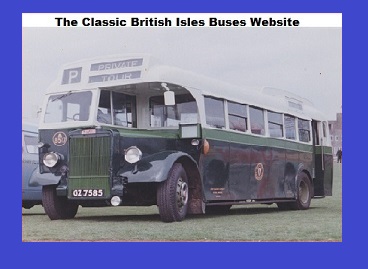
The Classic British Isles Buses Website
Ulsterbus 1977 to 1982 (by Shane Conway)
Last updated on 13 August 2024
Email
Classic U.K. Buses
Classic Irish Buses
Classic Manx Buses
By 1978 Ulsterbus had been in existence for eleven years, and in that period had placed a total of
around 920 new buses and coaches into service. Of these, only 40 were double deckers, and up to the end of 1977 eight of them
(or 20%) had already been lost in fires. Applying a statistic like this across the fleet gives some idea of the pressure that was
regularly inflicted on Northern Ireland's buses and bus-workers in those times. To offset the losses, secondhand buses were acquired
from U. K. operators, mainly ex Southdown and Ribble Leyland Leopards, although Ulsterbus also received some of the ex London AEC
Swifts and Merlins.
As the 1970s drew to a close, so too did the former U. T. A. fleet. The last examples of Tiger Cubs
and AEC Reliances were withdrawn in 1981, and this co-incided with the withdrawal of the last Bedford VAM14s, dating from 1967. 1980
also saw the last half cab to be withdrawn from active use, this being a 1947 Leyland PS1 which had served as a towbus in Armagh for
many years. Its replacement was the last of the six UTA built 1965 Leopards, this however didn't last long, as March 26th 1982 saw
what was one of the worst single attacks on the company when 26 buses (including the towbus) in Armagh depot were destroyed in one
night.
Surprisingly, given the almost 100% single deck fleet, further double deckers were acquired in the
1980s, mostly for school workings, following reports of concerns of overcrowding on single deckers on some runs. 25 Leyland AN68s
arrived from Strathclyde between 1982 and 1984, to be followed by similar buses from Lothian in 1985 and 1986.
By this time too, the last Leopards were being built in Alexander's plant in Mallusk, and the very
last one of all, 339, entered service in March 1984, carrying the final unit of almost 1500 examples of what had been the standard
Belfast built Ulsterbus body design since 1968. As the 1980s progressed other operators bought withdrawn Leopards, Bristols and
Bedfords for further service, Bus Eireann and Lough Swilly being the two largest buyers.
1977
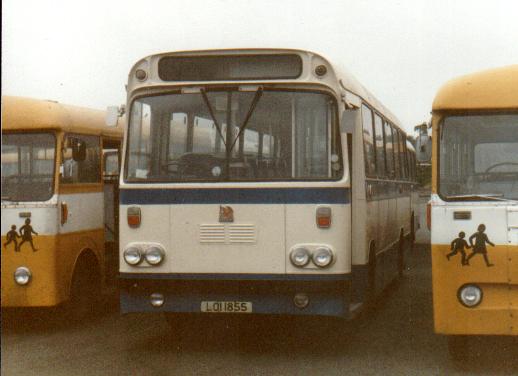
Bedford YLQ 1855 was one of 21 vehicles sold to Bus Eireann for school transport services after
1990. This bus, which also featured in Bedford publicity when new, is seen in Broadstone alongside buses which were to be replaced
by these vehicles.(Photo copyright Shane Conway)
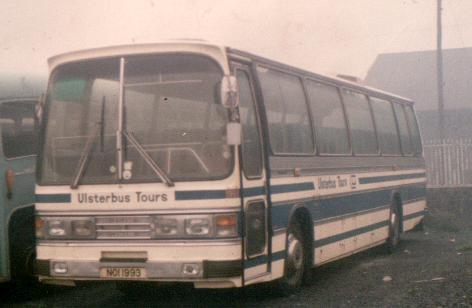
1993 was one of ten Duple Dominant Mk2s in the fleet and they were initially used on tours workings,
as depicted on November 17th 1984.(Photo copyright Shane Conway)
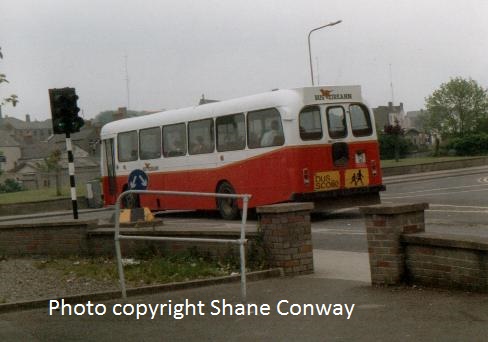
Ex Ulsterbus 2129 on April 29th 1992, having just left Drogheda bus station on a school service.
(Photo copyright Shane Conway)
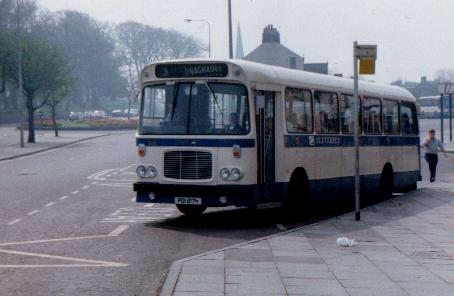
2174, seen at Bangor station on April 25th 1987, was one of the very few REs to work for Ulsterbus,
Citybus and Bus Eireann.(Photo copyright Shane Conway)
- 576 MTV 47P Bedford VAS5 FW450225 - Duple C29F 612/201056 new 2/1976 (to McEwen, Shirebrook); ex Wetherdair, Ballywalter 10/1977; w/d 5/1981; to Mullaly, Limerick 6/1981; r/r 697 YIU 6/1981; to Healy, Castlegar by 1/1984; to Deasy, Cork by 3/1985; sold for scrap by 1/1998
-
- 1851 LOI 1851 Bedford YLQ FW453192 - Alexander (B) B45F new 3/1977; destroyed in Ballycastle 7/1977 and scrapped at Magherafelt -/1979
- 1852 LOI 1852 Bedford YLQ FW453198 - Alexander (B) B45F new 3/1977; w/d 12/1987 and sold for scrap 11/1989
- 1855 LOI 1855 Bedford YLQ FW453458 - Alexander (B) B45F new 2/1977; w/d 9/1989; to Bus Eireann BA18 6/1990; r/r 77 D 138 6/1990; w/d 10/1997 and sold for scrap 5/1998
- 1856 LOI 1856 Bedford YLQ FW453462 - Alexander (B) B45F new 2/1977; w/d 9/1985 and sold for scrap 4/1986
- 1857 LOI 1857 Bedford YLQ FW453528 - Alexander (B) B45F new 1/1977; destroyed in Ballycastle 6/1978 and sold for scrap ?/??
- 1859 LOI 1859 Bedford YLQ FW453531 - Alexander (B) B45F 185/45 new 3/1977; w/d 5/1989; to Kilkeel Presbyterian Church 6/1989; to Haughey and Malone, Newry for preservation 3/2001 **SURVIVOR**
- 1860 LOI 1860 Bedford YLQ FW453532 - Alexander (B) B45F new 1/1977; towbus 3/1989 to 1/1993; w/d 1/1993 and sold for scrap 9/1994
- 1870 LOI 1870 Bedford YLQ FW455719 - Alexander (B) B45F new 2/1977; destroyed in Newry depot 29/2/1980 and sold for scrap 3/1980
- 1871 LOI 1871 Bedford YLQ FW455725 - Alexander (B) B45F new 1/1977; destroyed in Newry 8/1978 and sold for scrap 9/1978
- 1872 LOI 1872 Bedford YLQ FW455732 - Alexander (B) B45F new 2/1977; destroyed in Newry 8/1978 and sold for scrap 9/1978
- 1873 LOI 1873 Bedford YLQ FW455740 - Alexander (B) B45F new 1/1977; destroyed in Rathfriland 12/1979 and sold for scrap 1/1980
- 1874 LOI 1874 Bedford YLQ FW455823 - Alexander (B) B45F new 1/1977; w/d 12/1989; to Bus Eireann BA15 4/1990; r/r 77 D 131 4/1990; w/d by 2/1998 and sold for scrap 5/1999
- 1875 LOI 1875 Bedford YLQ FW455827 - Alexander (B) B45F 185/46 new 3/1977; towbus 7/1989 to 1/1997; w/d 1/1997 and sold for scrap 1/1997
- 1876 LOI 1876 Bedford YLQ FW455832 - Alexander (B) B45F new 3/1977; w/d 6/1989; to Bus Eireann BA12 11/1989; r/r 77 D 110 11/1989; w/d by 12/2001; to Spruhan, Bagenalstown by 12/2001 **SURVIVOR**
- 1877 LOI 1877 Bedford YLQ FW455837 - Alexander (B) B45F new 1/1977; towbus 5/1989 to 10/1995; w/d 10/1995 and sold for scrap 10/1995
- 1878 LOI 1878 Bedford YLQ FW455852 - Alexander (B) B45F new 1/1977; towbus from 3/1990; r/n 4878 7/2005; to Shannon, Newtownards 9/2006 for preservation **SURVIVOR**
- 1879 LOI 1879 Bedford YLQ FW455865 - Alexander (B) B45F new 1/1977; destroyed in Newry depot 29/2/1980 and sold for scrap 3/1980
- 1880 LOI 1880 Bedford YLQ FW455875 - Alexander (B) B45F new 3/1977; w/d 2/1990; to Bus Eireann BA16 4/1990; r/r 77 D 130 4/1990; w/d by 10/1997 and sold for scrap 5/1998
-
- 1966 NOI 1966 Leyland PSU3D/4R 7604877 - Alexander (B) DP49F new 6/1977; w/d 11/1990; to Bus Eireann LA25 3/1991; r/r 77 D 166 3/1991; w/d 7/2001 and sold for scrap by 2/2002
- 1967 NOI 1967 Leyland PSU3D/4R 7604994 - Alexander (B) DP49F new 5/1977; towbus 2/1995 to 8/2006; w/d 8/2006 and sold for scrap 7/2008
- 1968 NOI 1968 Leyland PSU3D/4R 7605107 - Alexander (B) DP49F new 5/1977; w/d 6/1992; to Bus Eireann LA37 7/1993; r/r 77 D 824 7/1993; w/d 8/2000; to Kells Transport Museum by 7/2001 **SURVIVOR**
- 1969 NOI 1969 Leyland PSU3D/4R 7605123 - Alexander (B) DP49F new 5/1977; w/d 6/1992 and sold for scrap 9/1994
- 1970 NOI 1970 Leyland PSU3D/4R 7605375 - Alexander (B) DP49F new 5/1977; w/d 6/1991; to Bus Eireann LA34 11/1992; r/r 77 D 215 11/1992; w/d 1/1997 and sold for scrap 10/1997
- 1971 NOI 1971 Leyland PSU3D/4R 7605394 - Alexander (B) DP49F new 5/1977; w/d 6/1992; to Bus Eireann LA35 5/1993; r/r 77 D 818 5/1993; w/d 7/1999 and sold for scrap ?/??
- 1972 NOI 1972 Leyland PSU3D/4R 7605396 - Alexander (B) DP49F new 5/1977; w/d 8/1992 and sold for scrap 7/1994
- 1973 NOI 1973 Leyland PSU3D/4R 7605497 - Alexander (B) DP49F new 5/1977; w/d 8/1992 and sold for scrap 7/1996
- 1974 NOI 1974 Leyland PSU3D/4R 7605510 - Alexander (B) DP49F new 6/1977; w/d 4/1992 and sold for scrap 4/1997
- 1975 NOI 1975 Leyland PSU3D/4R 7605530 - Alexander (B) DP49F new 6/1977; w/d 8/1992 and sold for scrap 7/1994
- 1976 NOI 1976 Leyland PSU3D/4R 7605647 - Alexander (B) DP49F new 5/1977; destroyed in Dungannon 2/1979 and sold for scrap 7/1980
- 1977 NOI 1977 Leyland PSU3D/4R 7605654 - Alexander (B) DP49F new 5/1977; destroyed in Armagh 4/1982 and sold for scrap 11/1982
- 1978 NOI 1978 Leyland PSU3D/4R 7605853 - Alexander (B) DP49F new 6/1977; w/d 6/1992; to Bus Eireann LA36 6/1993; r/r 77 D 819 6/1993; w/d 3/1998 and sold for scrap 2/1999
- 1979 NOI 1979 Leyland PSU3D/4R 7605910 - Alexander (B) DP49F new 5/1977; w/d 6/1992; to Bus Eireann LA38 7/1993; r/r 77 D 825 7/1993; w/d 12/2000 and sold for scrap by 7/2001
- 1980 NOI 1980 Leyland PSU3D/4R 7605192 - Alexander (B) DP49F new 7/1977; w/d 10/1990; to Bus Eireann LA27 3/1991; r/r 77 D 167 3/1991; w/d by 11/1999 and sold for scrap by 9/2000
- 1981 NOI 1981 Leyland PSU3E/4R 7605950 - Alexander (B) DP49F new 6/1977; w/d 7/1992; to Citybus 1981 6/1994; to towbus 6/1994; w/d 2/2010; to Kells Transport Museum 4/2010 **SURVIVOR**
- 1982 NOI 1982 Leyland PSU3E/4R 7605960 - Alexander (B) DP49F new 9/1977; w/d 8/1992 and sold for scrap 4/1997
- 1983 NOI 1983 Leyland PSU3E/4R 7606195 - Alexander (B) DP49F new 6/1977; to Great Victoria Street towbus 8/1994 to 4/2008; w/d 4/2008 and sold for scrap 9/2008
- 1984 NOI 1984 Leyland PSU3E/4R 7606360 - Alexander (B) DP49F new 6/1977; w/d 2/1992; used as storeshed (Larne) 2/1992 to 10/2001; sold for scrap 10/2001
- 1985 NOI 1985 Leyland PSU3E/4R 7606364 - Alexander (B) DP49F new 6/1977; w/d 8/1992 and sold for scrap 4/1997
- 1986 NOI 1986 Leyland PSU3E/4R 7606384 - Alexander (B) DP49F new 6/1977; destroyed in Warrenpoint 3/1988 and sold for scrap 7/1988
- 1987 NOI 1987 Leyland PSU3E/4R 7606394 - Alexander (B) DP49F new 6/1977; w/d 7/1978 following accident and sold for scrap 6/1980
- 1988 NOI 1988 Leyland PSU3E/4R 7606547 - Alexander (B) DP49F new 7/1977; destroyed in Dungannon 2/1979 and sold for scrap 1/1981
- 1989 NOI 1989 Leyland PSU3E/4R 7606566 - Alexander (B) DP49F new 9/1977; destroyed in Durgannon 2/1979 and sold for scrap 1/1981
- 1990 NOI 1990 Leyland PSU3E/4R 7606588 - Duple C49F 733/5231 new 6/1977; w/d ?/?? and sold for scrap by 8/1992
- 1991 NOI 1991 Leyland PSU3E/4R 7606617 - Duple C49F 733/5226 new 5/1977; w/d 6/1992 and sold for scrap 6/1995
- 1992 NOI 1992 Leyland PSU3E/4R 7606629 - Duple C49F 733/5227 new 5/1977; w/d 10/1991 following accident and sold for scrap by 6/1992
- 1993 NOI 1993 Leyland PSU3E/4R 7606948 - Duple C49F 733/5228 new 5/1977; w/d 5/1991; to T C T, Carraroe 7/1991; r/r 77 G 118 7/1991; scrapped by 3/1998
- 1994 NOI 1994 Leyland PSU3E/4R 7606962 - Duple C49F 733/5229 new 6/1977; w/d 3/1991 and sold for scrap 8/1993
- 1995 NOI 1995 Leyland PSU3E/4R 7606965 - Duple C49F 733/5230 new 6/1977; w/d 6/1992; to Chambers, Moneymore 12/1992; to McCrossan, Artigarvan by 3/1994; sold for scrap by 8/2000
-
- 2129 MOI 2129 Bristol RELL6G RELL-3-2159 - Alexander (B) B44D new 1/1977; w/d 3/1991; rebuilt to B49F by 12/1991; to Bus Eireann BG16 12/1991; r/r 77 D 183 12/1991; w/d 6/2000 and sold for scrap by 12/2000
- 2130 MOI 2130 Bristol RELL6G RELL-3-2160 - Alexander (B) B44D new 1/1977; destroyed in Derry 7/1985 and sold for scrap 10/1985
- 2131 MOI 2131 Bristol RELL6G RELL-3-2161 - Alexander (B) B44D new 2/1977; destroyed in Derry 6/1989 and sold for scrap 9/1989
- 2132 MOI 2132 Bristol RELL6G RELL-3-2162 - Alexander (B) B44D new 3/1977; destroyed in Derry 8/1989 and sold for scrap 9/1989
- 2133 MOI 2133 Bristol RELL6G RELL-3-2163 - Alexander (B) B44D new 2/1977; destroyed in Pennyburn 1/1992 and sold for scrap by 4/1992
- 2134 MOI 2134 Bristol RELL6G RELL-3-2164 - Alexander (B) B44D 183/14 new 2/1977; w/d 4/1992; rebuilt to B49F by 11/1992; to Bus Eireann BG39 11/1992; r/r 77 D 816 11/1992; w/d 11/2001; to Phipps, Dundrum 10/2002 for preservation; to Shannon, Newtownards 3/2008 for preservation **SURVIVOR**
- 2135 MOI 2135 Bristol RELL6G RELL-3-2165 - Alexander (B) B44D new 2/1977; destroyed in Derry 11/1990 and sold for scrap by 12/1990
- 2171 POI 2171 Bristol RELL6G RELL-3-2230 - Alexander (B) B52F 341/?? new 10/1977; w/d 5/1989; to Citybus 2171 5/1989; reseated to B51F 5/1989; w/d 1/1991; to Bus Eireann BG26 10/1992; r/r 77 D 206 10/1992; w/d 6/2001 and sold for scrap ?/??
- 2172 POI 2172 Bristol RELL6G RELL-3-2231 - Alexander (B) B52F 341/?? new 9/1977; w/d 5/1989; to Citybus 2172 5/1989; reseated to B51F 5/1989; w/d 9/1990; to Bus Eireann BG27 10/1992; r/r 77 D 207 10/1992; w/d 6/2000 and sold for scrap by 9/2003
- 2173 POI 2173 Bristol RELL6G RELL-3-2232 - Alexander (B) B52F 341/?? new 10/1977; w/d 9/1988; to Citybus 2173 5/1989; reseated to B51F 5/1989; w/d 1/1991; to Bus Eireann BG21 10/1992; r/r 77 D 201 10/1992; w/d 7/2001 and sold for scrap ?/??
- 2174 POI 2174 Bristol RELL6G RELL-3-2233 - Alexander (B) B52F 341/?? new 10/1977; w/d 8/1989; to Citybus 2174 9/1989; reseated to B51F 9/1989; w/d 1/1991; to Bus Eireann BG22 10/1992; r/r 77 D 202 10/1992; w/d 9/1998 and sold for scrap by 5/1999
- 2175 POI 2175 Bristol RELL6G RELL-3-2234 - Alexander (B) B52F 341/?? new 10/1977; w/d 8/1989; to Citybus 2175 9/1989; reseated to B51F 9/1989; w/d 1/1991; to Bus Eireann BG23 10/1992; r/r 77 D 203 10/1992; w/d 10/1999 and sold for scrap 3/2001
- 2176 POI 2176 Bristol RELL6G RELL-3-2235 - Alexander (B) B52F 341/?? new 10/1977; w/d 8/1989; to Citybus 2176 9/1989; reseated to B51F 9/1989; w/d 1/1991; to Bus Eireann BG24 10/1992; r/r 77 D 204 10/1992; burnt out 1/1994 and sold for scrap 1/1995
- 2177 POI 2177 Bristol RELL6G RELL-3-2236 - Alexander (B) B52F 341/?? new 10/1977; w/d 6/1989; to Citybus 2177 9/1989; reseated to B51F 9/1989; w/d 1/1991; to Bus Eireann BG25 10/1992; r/r 77 D 205 10/1992; w/d 5/2001 and sold for scrap by 11/2002
- 2178 POI 2178 Bristol RELL6G RELL-3-2237 - Alexander (B) B52F 341/?? new 11/1977; w/d 3/1996 and sold for scrap 9/1996
- 2179 POI 2179 Bristol RELL6G RELL-3-2238 - Alexander (B) B52F 341/?? new 11/1977; w/d 6/1988; to Citybus 2179 7/1988; reseated to B51F 7/1988; w/d 8/1991; to Bus Eireann BG28 10/1992; r/r 77 D 208 10/1992; w/d 1/2000 and sold for scrap
- 2180 POI 2180 Bristol RELL6G RELL-3-2239 - Alexander (B) B52F 341/?? new 12/1977; w/d 3/1993; to Bus Eireann BG43 5/1993; r/r 78 D 825 5/1993; w/d 12/2000 and sold for scrap 3/2001; also reported as sold to Kells Transport Museum by 8/2004 for preservation; Possible **SURVIVOR**
- 2181 POI 2181 Bristol RELL6G RELL-3-2240 - Alexander (B) B52F 341/?? new 11/1977; w/d 10/1994 and sold for scrap 4/1997
- 2182 POI 2182 Bristol RELL6G RELL-3-2241 - Alexander (B) B52F 341/?? new 11/1977; w/d 10/1994 and sold for scrap 3/1996
- 2183 POI 2183 Bristol RELL6G RELL-3-2242 - Alexander (B) B52F 341/?? new 11/1977; destroyed in Pennyburn depot 31/2012/1992 and sold for scrap by 5/1993
- 2184 POI 2184 Bristol RELL6G RELL-3-2243 - Alexander (B) B52F 341/?? new 11/1977; w/d 1/1993 following accident damage and sold for scrap 6/1994
- 2185 POI 2185 Bristol RELL6G RELL-3-2244 - Alexander (B) B52F 341/?? new 12/1977; w/d 2/1996 and sold for scrap 4/1997
- 2186 POI 2186 Bristol RELL6G RELL-3-2245 - Alexander (B) B52F 341/?? new 12/1977; w/d 3/1997 and sold for scrap 12/1997
- 2187 POI 2187 Bristol RELL6G RELL-3-2246 - Alexander (B) B52F 341/?? new 12/1977; w/d 2/1997; to Chambers, Moneymore 12/1997; to Keenan, Bellurgan by 12/1998; r/r 77 LH 519 by 12/1998; to Kells Transport Museum by 1/2002; scrapped -/2020
- 2188 POI 2188 Bristol RELL6G RELL-3-2247 - Alexander (B) B52F 341/?? new 12/1977; destroyed in Lurgan 8/1989 and sold for scrap 12/1989
- 2189 POI 2189 Bristol RELL6G RELL-3-2248 - Alexander (B) B52F 341/?? new 12/1977; w/d 3/1993; to Bus Eireann BG44 6/1993; r/r 77 D 822 6/1993; w/d 8/1999 and sold for scrap 3/2001
- 2190 POI 2190 Bristol RELL6G RELL-3-2249 - Alexander (B) B52F 341/?? new 12/1977; w/d 11/1999; to Hart, York 5/2000 **SURVIVOR** Preserved as Ulsterbus 2190
- 2191 POI 2191 Bristol RELL6G RELL-3-2250 - Alexander (B) B52F 341/?? new 12/1977; destroyed in Oxford Street 2/1986 and sold for scrap 4/1986
- 2192 POI 2192 Bristol RELL6G RELL-3-2251 - Alexander (B) B52F 341/?? new 12/1977; w/d 6/1989; to Citybus 2192 6/1989; reseated to B51F 6/1989; w/d 2/1991; to Bus Eireann BG36 10/1992; r/r 77 D 213 10/1992; w/d 12/2001; to Kells Transport Museum by 11/2002; scrapped -/2020
- 2193 POI 2193 Bristol RELL6G RELL-3-2252 - Alexander (B) B52F 341/?? new 12/1977; w/d 2/1993; to Bus Eireann BG40 6/1993; r/r 78 D 824 6/1993; w/d 11/2001; to Bedford, Celbridge 12/2001 for spares; resold 1/2006 and currently stored for future restoration **SURVIVOR**
- 2197 POI 2197 Bristol RELL6G RELL-3-2256 - Alexander (B) B52F 341/?? new 12/1977; w/d 8/1989; to Citybus 2197 9/1989; reseated to B51F 9/1989; w/d 10/1991; to Bus Eireann BG34 11/1992; r/r 77 D 212 11/1992; w/d 7/2001 and sold for scrap by 11/2002
-
- 2489 VLW 454G AEC Merlin 4P2R-511 - MCW B25D new 3/1969 (as London Transport MBS454); ex London Transport MBA454 11/1977; used as mobile office 4/1978 to 11/1978; stripped for spares and sold for scrap 5/1980
- 2490 VLW 460G AEC Merlin 4P2R-517 - MCW B25D new 5/1969 (as London Transport MBS460); ex London Transport MBA460 11/1977; w/d 3/1980; to Citybus 2490 3/1980; destroyed in Ardoyne 12/1980 and sold for scrap ?/??
- 2491 VLW 461G AEC Merlin 4P2R-518 - MCW B32D new 5/1969 (as London Transport MBS461); ex London Transport MBA461 11/1977; w/d 11/1980 and sold for scrap 4/1981
- 2492 VLW 465G AEC Merlin 4P2R-522 - MCW B32D new 5/1969 (as London Transport MBS465); ex London Transport MBA465 11/1977; w/d 10/1980 and sold for scrap 12/1980
- 2494 VLW 527G AEC Merlin 4P2R-584 - MCW B32D new 6/1969 (as London Transport MBS527); ex London Transport MBA527 11/1977; destroyed 11/1978 and sold for scrap ?/??
- 2496 AML 548H AEC Merlin 4P2R-605 - MCW B32D new 1/1970 (as London Transport MBS548); ex London Transport MBA548 11/1977; destroyed in Pennyburn 12/1978 and sold for scrap 12/1978
- 2497 AML 576H AEC Merlin 4P2R-632 - MCW B25D new 9/1969 (as London Transport MBS576); ex London Transport MBA576 11/1977; w/d 3/1980; to Citybus 2497 3/1980; r/n 670 9/1981; w/d 1981 and sold for scrap ?/??
- 2506 VLW 312G AEC Merlin 4P2R-370 - MCW B50F new 10/1968; ex London Transport MB312 5/1977; w/d 6/1980 and sold for scrap 10/1980
- 2507 VLW 360G AEC Merlin 4P2R-417 - MCW B50F new 11/1968; ex London Transport MB360 5/1977; destroyed in Newry depot 29/2/1980 and sold for scrap 3/1980
- 2508 VLW 370G AEC Merlin 4P2R-427 - MCW B50F new 10/1968; ex London Transport MB370 5/1977; w/d 5/1980; to Citybus 2508 5/1980; w/d 10/1980 and sold for scrap ?/??
- 2509 AML 631H AEC Merlin 4P2R-753 - MCW B50F new 8/1969; ex London Transport MB631 5/1977; w/d 9/1980 and sold for scrap ?/??
- 2510 AML 658H AEC Merlin 4P2R-780 - MCW B32D new 10/1969; ex London Transport MB658 5/1977; destroyed in Dungannon 5/1978 and sold for scrap 12/1978
- 2511 VLW 346G AEC Merlin 4P2R-403 - MCW B50F new 5/1969; ex London Transport MB346 5/1977; w/d 3/1980; to Citybus 2511 3/1980; r/n 673 9/1981; w/d 3/1982 and sold for scrap ?/??
- 2512 VLW 352G AEC Merlin 4P2R-409 - MCW B50F new 11/1968; ex London Transport MB352 5/1977; w/d 3/1980; to Citybus 2512 3/1980; w/d 4/1981 and sold for scrap ?/??
- 2513 VLW 353G AEC Merlin 4P2R-410 - MCW B50F new 11/1968; ex London Transport MB353 5/1977; w/d 3/1980; to Citybus 2513 3/1980; destroyed in Belfast 8/1981 and sold for scrap ?/??
- 2514 VLW 354G AEC Merlin 4P2R-411 - MCW B50F new 11/1968; ex London Transport MB354 5/1977; destroyed in Dungannon 5/1978 and sold for scrap 12/1978
- 2515 VLW 356G AEC Merlin 4P2R-413 - MCW B50F new 11/1968; ex London Transport MB356 5/1977; w/d 5/1980 and sold for scrap 5/1980
- 2516 VLW 362G AEC Merlin 4P2R-419 - MCW B50F new 11/1968; ex London Transport MB362 5/1977; destroyed in Dungannon 6/1979 and sold for scrap 12/1980
- 2517 VLW 364G AEC Merlin 4P2R-421 - MCW B50F new 11/1968; ex London Transport MB364 5/1977; w/d 3/1980; to Citybus 2517 3/1980; r/n 674 9/1981; destroyed 3/1982 and sold for scrap ?/??
- 2518 VLW 387G AEC Merlin 4P2R-444 - MCW B50F new 12/1968; ex London Transport MB387 5/1977; w/d 3/1980; to Citybus 2518 3/1980; destroyed in Belfast 5/1981 and sold for scrap ?/??
- 2519 AML 651H AEC Merlin 4P2R-773 - MCW B50F new 3/1970; ex London Transport MB651 5/1977; w/d 6/1980 and sold for scrap 3/1981
- 2520 AML 657H AEC Merlin 4P2R-779 - MCW B50F new 10/6; ex London Transport MB657 5/1977; destroyed in Meigh 2/1979 and sold for scrap 6/1979
- 2521 VLW 329G AEC Merlin 4P2R-387 - MCW B50F new 10/1968; ex London Transport MB329 3/1977; destroyed in Meigh 10/1977 and sold for scrap 6/1979
- 2522 VLW 366G AEC Merlin 4P2R-423 - MCW B50F new 11/1968; ex London Transport MB366 3/1977; w/d 3/1980; to Citybus 2522 3/1980; destroyed in Belfast 8/1981 and sold for scrap ?/??
- ---- VLW 156G AEC Merlin 3P2R-185 - MCW B50F new 11/1968; ex London Transport MB156 7/1977; stripped for spares and sold for scrap ?/??
- ---- VLW 344G AEC Merlin 4P2R-401 - MCW B50F new 11/1968; ex London Transport MB344 7/1977; stripped for spares and sold for scrap ?/??
-
- 2704 1704 MZ Leyland PDR1/201 L21762 – MH Coachworks H44/33F new 12/64 (as Belfast Corporation 704); ex Citybus 2704 4/1977; w/d 1/1978 and sold for scrap 9/1979
- 2705 1705 MZ Leyland PDR1/201 L21763 – MH Coachworks H44/33F new 12/64 (as Belfast Corporation 705); ex Citybus 2705 4/1977; w/d 5/1978 and sold for scrap 9/1979
- 2706 1706 MZ Leyland PDR1/201 L21764 – MH Coachworks H44/33F new 1/65 (as Belfast Corporation 706); ex Citybus 2706 11/1977; w/d 6/1979 and sold for scrap 9/1979
-
- 2707 707 UZ Daimler CRG6LX 62182 – Potters H44/30F new 6/1967 (as Belfast Corporation 707); ex Citybus 2707 12/1977; destroyed in Pennyburn 12/1978 and sold for scrap 12/1978
- 2709 709 UZ Daimler CRG6LX 62184 – Potters H44/30F new 6/1967 (as Belfast Corporation 709); ex Citybus 2709 12/1977; destroyed in Pennyburn 12/1978 and sold for scrap 12/1978
- 2712 712 UZ Daimler CRG6LX 62187 – Potters H44/30F new 6/1967 (as Belfast Corporation 712); ex Citybus 2712 1/1978; to Citybus 2712 4/1982; driver trainer 4/1982 to 5/1983; w/d 5/1983; to Irish Transport Trust 3/1984; to Ulsterbus 11/1985 in exchange for Leopard 1337; sold for scrap 11/1985
- 2716 716 UZ Daimler CRG6LX 62191 – Alexander (B) H44/31F new 8/1967 (as Belfast Corporation 716); ex Citybus 2716 4/1978; rebuilt to O44/31F 7/1981; w/d 8/1993 and sold for scrap 9/1994
- 2718 718 UZ Daimler CRG6LX 62193 – Potters H44/30F new 8/1967 (as Belfast Corporation 718); ex Citybus 2718 4/1973 1/1978; w/d 9/1981 and sold for scrap 3/1982
- 2719 719 UZ Daimler CRG6LX 62194 – Potters H44/30F new 8/1967 (as Belfast Corporation 719); ex Citybus 2719 4/1973 4/1978; w/d 10/1980 and sold for scrap 8/1982
- 2722 722 UZ Daimler CRG6LX 62197 – Potters H44/30F new 9/1967 (as Belfast Corporation 722); ex Citybus 2722 4/1973 4/1978; w/d 4/1979 and sold for scrap 3/1981
- 2723 723 UZ Daimler CRG6LX 62198 – Potters H44/30F new 9/1967 (as Belfast Corporation 723); ex Citybus 2723 4/1973 4/1978; w/d 11/1980 and sold for scrap 3/1981
- 2725 725 UZ Daimler CRG6LX 62200 – Potters H44/30F new 9/1967 (as Belfast Corporation 725); ex Citybus 2725 4/1973 10/1977; w/d 6/1979 and sold for scrap 3/1981
- 2726 726 UZ Daimler CRG6LX 62201 – Potters H44/30F new 10/1967 (as Belfast Corporation 726); ex Citybus 2726 4/1973 10/1977; w/d 2/1981 and sold for scrap 3/1982
- 2727 727 UZ Daimler CRG6LX 62202 – Potters H44/30F new 11/1967 (as Belfast Corporation 727); ex Citybus 2727 4/1973 8/1977; w/d 2/1982 and sold for scrap 6/1983
- 2728 728 UZ Daimler CRG6LX 62203 – Potters H44/30F new 11/1967 (as Belfast Corporation 728); ex Citybus 2728 4/1973 7/1977; destroyed in Pennyburn 12/1978 and sold for scrap 12/1978
- 2729 729 UZ Daimler CRG6LX 62204 – Potters H44/30F new 11/1967 (as Belfast Corporation 729); ex Citybus 2729 4/1973 7/1977; w/d 2/1981; to Voluntary Services Board, Belfast 5/1981; converted to playbus 5/1981; sold for scrap by 6/1991
- 2730 730 UZ Daimler CRG6LX 62205 – Potters H44/30F new 11/1967 (as Belfast Corporation 730); ex Citybus 2730 4/1973 6/1977; w/d 11/1978 and sold for scrap 11/1979
1978
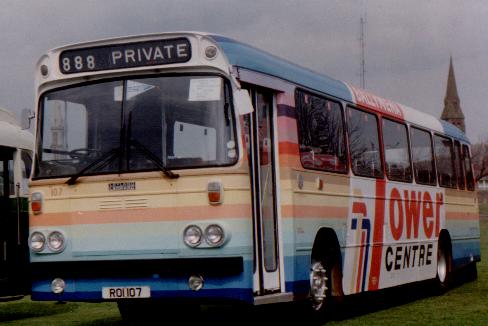
1978 Leopard 107 was painted to advertise the Ballymena Tower Centre, as seen in Bangor on April
26th 1986. Note that the number plate has been moved from above the bumper to below it.(Photo copyright Shane Conway)
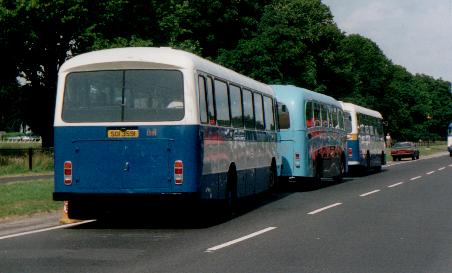
Preserved 1591 seen in Dublin's Phoenix Park on June 27th 1992 while attending the Dublin Bay rally.
The other buses are ex UTA AEC Reliance 234 and Bristol LH 1629.(Photo copyright Shane Conway)
- 1 EGN 187J AEC Swift 4MP2R1-605 - Marshall B33D B4569 new 10/1970; ex London Transport SMS187 2/1978; used as mobile office 4/1978 to 11/1978; sold for scrap ?/??
- 4 EGN 206J AEC Swift 4MP2R1-754 - Marshall B33D B4596 new 9/1971; ex London Transport SMS206 2/1978; w/d 2/1980; to Citybus 4 2/1980; w/d 1980 and sold for scrap ?/??
- 7 EGN 374J AEC Swift 4MP2R1-805 - Park Royal B33D B57413 new 1/1971; ex London Transport SMS374 4/1978; w/d 4/1980 and sold for scrap 4/1980
- 8 EGN 380J AEC Swift 4MP2R1-870 - Park Royal B33D B57419 new 1/1971; ex London Transport SMS380 4/1978; used as mobile office 4/1978 to 11/1978; sold for scrap ?/??
- 9 EGN 590J AEC Swift 4MP2R1-948 - MCW B33D new 4/1971; ex London Transport SMS590 4/1978; used as mobile office 4/1978 to 11/1978; sold for scrap ?/??
- 10 EGN 596J AEC Swift 4MP2R2-1056 - MCW B33D new 4/1971; ex London Transport SMS596 4/1978; used as mobile office 4/1978 to 11/1978; sold for scrap ?/??
- 12 EGN 559J AEC Swift 4MP2R1-720 - MCW B33D new 3/1971; ex London Transport SMS559 4/1978; w/d 6/1979; to storeshed at Lisburn 1/1980; sold for scrap ?/??
- 13 EGN 560J AEC Swift 4MP2R1-935 - MCW B33D new 3/1971; ex London Transport SMS560 4/1978; w/d 2/1980; to Citybus 13 2/1980; w/d 1980 and sold for scrap ?/??
- 14 EGN 561J AEC Swift 4MP2R1-761 - MCW B33D new 3/1971; ex London Transport SMS561 4/1978; destroyed in Oxford Street 2/1980 and sold for scrap 4/1980
- 15 EGN 562J AEC Swift 4MP2R1-748 - MCW B33D new 3/1971; ex London Transport SMS562 4/1978; w/d 12/1979; to Citybus 15 12/1979; w/d 5/1980 and sold for scrap ?/??
- 17 EGN 579J AEC Swift 4MP2R2-1022 - MCW B33D new 4/1971; ex London Transport SMS579 4/1978; w/d 3/1980; to Citybus 17 3/1980; w/d 1980 and sold for scrap ?/??
- 18 EGN 608J AEC Swift 4MP2R2-1070 - MCW B33D new 5/1971; ex London Transport SMS608 4/1978; w/d 3/1980; to Citybus 18 3/1980; w/d 1980 and sold for scrap ?/??
- 25 EGN 594J AEC Swift 4MP2R2-1054 - MCW B33D new 4/1971; ex London Transport SMS594 5/1978; w/d 3/1980; to Citybus 25 3/1980; destroyed in Ardoyne depot 7/197/1980 and sold for scrap
- 26 EGN 660J AEC Swift 4MP2R3-1105 - MCW B33D new 7/1971; ex London Transport SMS660 5/1978; w/d 11/1979 and sold for scrap 4/1980
-
- 101 ROI 101 Leyland PSU3E/4R 7801010 - Duple C53F 833/5121 new 8/1978; destroyed in Armagh 4/1982 and sold for scrap 8/1982
- 102 ROI 102 Leyland PSU3E/4R 7801110 - Duple C53F 833/5122 new 8/1978; to TCT, Carraroe 4/1990; r/r 78 G 140 4/1990; scrapped by 3/1998
- 103 ROI 103 Leyland PSU3E/4R 7801170 - Duple C53F 833/5123 new 8/1978; destroyed in Barghagh 8/1988 and sold for scrap 9/1988
- 104 ROI 104 Leyland PSU3E/4R 7801205 - Duple C53F 833/5124 new 8/1978; w/d 12/1986 and sold for scrap 10/1989
-
- 105 ROI 105 Leyland PSU3E/4R 7705602 - Alexander (B) DP49F 360/1 new 4/1978; w/d 2/1997 and sold for scrap 9/2000
- 106 ROI 106 Leyland PSU3E/4R 7705699 - Alexander (B) DP49F 360/3 new 4/1978; destroyed in Pennyburn 7/1982 and sold for scrap 2/1983
- 107 ROI 107 Leyland PSU3E/4R 7705846 - Alexander (B) DP49F 360/2 new 4/1978; towbus from 8/1999; r/r CCZ 5919 10/1999; r/n 4107 4/2003; w/d 11/2010; to Davis, Kirk Michael 11/2010 for preservation **SURVIVOR**
- 108 ROI 108 Leyland PSU3E/4R 7705928 - Alexander (B) DP49F 360/8 new 5/1978; to Magherafelt towbus from 5/2002; r/r SCZ 2658 4/2003; r/n 4108 4/2003; to Omagh towbus 3/2010; w/d 4/2011; to Davis, Kirk Michael 4/2011; to Nogues, Bangor; r/r RUI 108 -/2019; to Thompson, Newtownards 2/2021 for preservation **SURVIVOR**
- 109 ROI 109 Leyland PSU3E/4R 7800069 - Alexander (B) DP49F 360/5 new 5/1978; r/r WAZ 5652 8/1998; renumbered 4109 7/2003; w/d 5/2006 and sold for scrap 10/2006
- 110 ROI 110 Leyland PSU3E/4R 7800138 - Alexander (B) DP49F 360/4 new 5/1978; destroyed in Toomebridge 4/1981 and sold for scrap 4/1981
- 111 ROI 111 Leyland PSU3E/4R 7800303 - Alexander (B) DP49F 360/13 new 6/1978; towbus from 6/1996; r/r TBZ 8399 5/1998; renumbered 4111 4/2003; w/d 12/2009; to Watson, Newcastle 12/2009 **SURVIVOR**
- 112 ROI 112 Leyland PSU3E/4R 7800345 - Alexander (B) DP49F 360/6 new 5/1978; w/d 12/2001 and sold for scrap 7/2003
- 113 ROI 113 Leyland PSU3E/4R 7800306 - Alexander (B) DP49F 360/9 new 5/1978; w/d 9/1999 and sold for scrap 9/2000
- 114 ROI 114 Leyland PSU3E/4R 7800702 - Alexander (B) DP49F 360/7 new 5/1978; destroyed in Strabane 2/1988 and sold for scrap 8/1988
- 115 ROI 115 Leyland PSU3E/4R 7800737 - Alexander (B) DP49F 360/12 new 6/1978; destroyed in Dungannon 2/1979 and sold for scrap 7/1980
- 116 ROI 116 Leyland PSU3E/4R 7800772 - Alexander (B) DP49F 360/10 new 5/1978; w/d 6/2000 and sold for scrap 3/2002 (although noted in breakers yard by 9/2001)
- 117 ROI 117 Leyland PSU3E/4R 7800811 - Alexander (B) DP49F 360/11 new 6/1978; to Newtownabbey towbus 4/1998; r/r YAZ 6412 2/1999; r/n 4117 4/2003; w/d 12/2009; to Kells Transport Museum 12/2009 **SURVIVOR**
- 118 ROI 118 Leyland PSU3E/4R 7801337 - Alexander (B) DP49F 360/14 new 8/1978; to Omagh towbus 1/2001; r/r ICZ 3919 3/2001; r/n 4118 4/2003; w/d 3/2010; to Kells Transport Museum 7/2010 for preservation
- 119 ROI 119 Leyland PSU3E/4R 7801510 - Alexander (B) DP49F 360/15 new 7/1978; r/r HCZ 1770 11/2000; w/d 3/2000 and sold for scrap 4/2001
- 120 ROI 120 Leyland PSU3E/4R 7801537 - Alexander (B) DP49F 360/27 new 10/1978; towbus from 11/2000; r/r HCZ 5695 1/2001; r/n 4120 4/2003; w/d ?/??; to Kells Transport Museum 8/2010 **SURVIVOR**
- 121 ROI 121 Leyland PSU3E/4R 7801561 - Alexander (B) DP49F 360/16 new 7/1978; loaned to CIE 7/1984 to 8/1984; destroyed in Larne 8/1990 and sold for scrap 10/1990
- 122 ROI 122 Leyland PSU3E/4R 7801699 - Alexander (B) DP49F 360/18 new 8/1978; w/d 6/1992; to Share Centre, Enniskillen 8/1995; to unknown 2/2008; r/r FIG 9847 3/2008 **SURVIVOR**
- 123 ROI 123 Leyland PSU3E/4R 7801702 - Alexander (B) DP49F 360/33 new 11/1978; w/d 11/1999 and sold for scrap 3/2001
- 124 ROI 124 Leyland PSU3E/4R 7801705 - Alexander (B) DP49F 360/21 new 9/1978; w/d 5/1997 and sold for scrap 3/1998
- 125 ROI 125 Leyland PSU3E/4R 7801658 - Alexander (B) DP49F 360/31 new 11/1978; w/d 11/1997 and sold for scrap 4/1998
- 126 ROI 126 Leyland PSU3E/4R 7801709 - Alexander (B) DP49F 360/17 new 8/1978; to Dungannon towbus 3/1998; r/n 4126 4/2003; r/r FEZ 8166 11/2005; w/d 4/2010; to Kells Transport Museum 4/2010 **SURVIVOR**
- 127 ROI 127 Leyland PSU3E/4R 7801540 - Alexander (B) DP49F 360/22 new 10/1978; w/d 12/2003; r/r WCZ 2011 3/2004; sold for scrap 5/2006
- 128 ROI 128 Leyland PSU3E/4R 7801595 - Alexander (B) DP49F 360/23 new 10/1978; accident damaged 10/2001; r/r LCZ 9742 1/2002 and sold for scrap 4/2002
- 129 ROI 129 Leyland PSU3E/4R 7801952 - Alexander (B) DP49F 360/25 new 10/1978; r/r FEZ 8627 11/2005; w/d 5/2006; to Thompson, Newtownards 7/2006 for preservation; to McAlinney, Newtownards 3/2007 for preservation; r/r RUI 129 3/2007 r/r ROI 129 2/2022 **SURVIVOR**
- 130 ROI 130 Leyland PSU3E/4R 7801971 - Alexander (B) DP49F 360/28 new 10/1978; w/d 10/2003; driver trainer 1/2004 to 5/2005; r/r DEZ 7475 6/2005; to Asia Bus Response 6/2005 **SURVIVOR**
- 131 ROI 131 Leyland PSU3E/4R 7802246 - Alexander (B) DP49F 360/29 new 8/1978; w/d 10/2005; r/r FEZ 5575 11/2005; sold for scrap 5/2006
- 132 ROI 132 Leyland PSU3E/4R 7802326 - Alexander (B) DP49F 360/20 new 9/1978; w/d 1/2006; r/r GEZ 6232 2/2006; sold for scrap 7/2006
- 133 ROI 133 Leyland PSU3E/4R 7802556 - Alexander (B) DP49F 360/26 new 10/1978; r/r VCZ 4093 1/2004; w/d 1/2006 and sold for scrap 6/2006
- 135 ROI 135 Leyland PSU3E/4R 7802703 - Alexander (B) DP49F 360/24 new 10/1978; w/d 10/2001; r/r LCZ 7113 1/2002 and sold for scrap 4/2002
- 136 ROI 136 Leyland PSU3E/4R 7802722 - Alexander (B) DP49F 360/29 new 11/1978; w/d 6/2000 and sold for scrap 12/2000
- 137 ROI 137 Leyland PSU3E/4R 7803039 - Alexander (B) DP49F 360/34 new 12/1978; w/d 2/2000 and sold for scrap 4/2001 (although noted in breakers yard by 8/2000)
- 140 ROI 140 Leyland PSU3E/4R 7803051 - Alexander (B) DP49F 360/30 new 11/1978; w/d 12/2003; r/r VCZ 9398 2/2004 and sold for scrap 5/2005
- 143 ROI 143 Leyland PSU3E/4R 7803431 - Alexander (B) DP49F 360/32 new 11/1978; destroyed in Armagh 4/1982 and sold for scrap 8/1982 (first of batch to be withdrawn)
- 146 ROI 146 Leyland PSU3E/4R 7803045 - Alexander (B) DP49F 360/36 new 12/1978; w/d 11/2003; r/r UCZ 9654 12/2003 and sold for scrap 12/2004
- 147 ROI 147 Leyland PSU3E/4R 7803790 - Alexander (B) DP49F 360/37 new 12/1978; w/d 1/2006; r/r HEZ 1012 3/2006; to Police Service of Northern Ireland 3/2006 **SURVIVOR**
-
- 569 EMD 607J Leyland PSU3B/4R 7100628 – Plaxton C53F 713119 new 7/1971; ex Grey Green, London 5/1978; w/d 7/1985 and sold for scrap 4/1986
- 570 EMD 608J Leyland PSU3B/4R 7100515 – Plaxton C53F 713250 new 6/1971; ex Grey Green, London 5/1978; w/d 4/1984 and sold for scrap 7/1986
- 571 EMD 609J Leyland PSU3B/4R 7100514 – Plaxton C53F 713111 new 6/1971; ex Grey Green, London 5/1978; w/d 12/1983 and sold for scrap 11/1985
- 572 EMD 610J Leyland PSU3B/4R 7100470 – Plaxton C49F 713256 new 5/1971; ex Grey Green, London 5/1978; w/d 6/1984 and sold for scrap 1/1988
- 573 EMD 611J Leyland PSU3B/4R 7100650 – Plaxton C49F 713267 new 6/1971; ex Grey Green, London 5/1978; w/d 1/1984 and sold for scrap by 9/1993
- 574 GGH 612J Leyland PSU3B/4RT 7101380 – Plaxton C53F 713240 new 6/1971; ex Grey Green, London 5/1978; w/d 12/1983 and sold for scrap 11/1987
- 575 XJH 429K Leyland PSU5/4R 7101823 – Plaxton C53F 713298 new 6/1971; ex Grey Green, London 5/1978; reseated to C57F 5/1980; w/d 12/1984 and sold for scrap 12/1986
-
- 1830 POI 9830 Bedford YLQ GW452201 - Duple C45F 815/2128 new 3/1978; w/d 12/1980; to Killarney Autos 1/1981; not reported as being re-registered; sold for scrap by 3/1993
-
- 2194 POI 2194 Bristol RELL6G RELL-3-2253 - Alexander (B) B52F 341/?? new 1/1978; w/d 6/1994 and sold for scrap 4/1997
- 2195 POI 2195 Bristol RELL6G RELL-3-2254 - Alexander (B) B52F 341/?? new 1/1978; w/d 8/1989; to Citybus 2195 9/1989; reseated to B51F 9/1989; w/d 5/1990 and sold for scrap 6/1990
- 2196 POI 2196 Bristol RELL6G RELL-3-2255 - Alexander (B) B52F 341/?? new 1/1978; w/d 6/1989; to Citybus 2196 9/1989; reseated to B51F 9/1989; w/d 6/1991; to Bus Eireann BG33 10/1992; r/r 78 D 402 10/1992; w/d 10/2001 and sold for scrap 12/2001
- 2198 POI 2198 Bristol RELL6G RELL-3-2257 - Alexander (B) B52F 341/28 new 1/1978; w/d 6/1989; to Citybus 2198 9/1989; reseated to B51F 9/1989; w/d 6/1991; to Bus Eireann BG35 11/1992; r/r 78 D 403 11/1992; w/d by 3/2001 and sold for scrap 3/2001; also reported as sold to Kells Transport Museum by 8/2004 for preservation; Possible **SURVIVOR**
- 2199 POI 2199 Bristol RELL6G RELL-3-2258 - Alexander (B) B52F 341/30 new 1/1978; w/d 5/1997; to Crossfire Trust, Keady 1/1998 **SURVIVOR**
- 2200 POI 2200 Bristol RELL6G RELL-3-2259 - Alexander (B) B52F 341/29 new 1/1978; w/d 3/1996 and sold for scrap 3/1998
- 2201 POI 2201 Bristol RELL6G RELL-3-2260 - Alexander (B) B52F 341/31 new 1/1978; w/d 11/1994 and sold for scrap 4/1997
- 2202 POI 2202 Bristol RELL6G RELL-3-2261 - Alexander (B) B52F 341/37 new 1/1978; w/d 11/1994 and sold for scrap 4/1997
- 2203 POI 2203 Bristol RELL6G RELL-3-2262 - Alexander (B) B52F 341/33 new 2/1978; w/d 4/1995; used as storeshed at Craigavon and sold for scrap 11/2000
- 2204 POI 2204 Bristol RELL6G RELL-3-2263 - Alexander (B) B52F 341/38 new 5/1978; w/d 3/1994 following accident damage and sold for scrap 7/1995
- 2205 POI 2205 Bristol RELL6G RELL-3-2264 - Alexander (B) B52F 341/35 new 2/1978; w/d 2/1997; to Chambers, Moneymore 12/1997; to Lally, Galway 6/1998; r/r 78 G 962 6/1998; w/d by 7/2001 and sold for scrap by 9/2003
- 2206 POI 2206 Bristol RELL6G RELL-3-2265 - Alexander (B) B52F 341/39 new 2/1978; destroyed in Pennyburn 2/1978 and sold for scrap 7/1980
- 2207 POI 2207 Bristol RELL6G RELL-3-2266 - Alexander (B) B52F 341/36 new 2/1978; destroyed in Pennyburn 2/1978 and sold for scrap 7/1980
- 2208 POI 2208 Bristol RELL6G RELL-3-2267 - Alexander (B) B52F 341/32 new 2/1978; w/d 10/1994 and sold for scrap 2/1997
- 2209 POI 2209 Bristol RELL6G RELL-3-2268 - Alexander (B) B52F 341/34 new 2/1978; destroyed in Pennyburn 2/1978 and sold for scrap 1/1981
- 2210 POI 2210 Bristol RELL6G RELL-3-2269 - Alexander (B) B52F 341/40 new 2/1978; destroyed in Pennyburn 7/1982 and sold for scrap 9/1982
-
- 2231 ROI 2231 Bristol RELL6G RELL-3-2314 - Alexander (B) B52F 341/47 new 7/1978; w/d 2/2000 and sold for scrap 6/2003
- 2232 ROI 2232 Bristol RELL6G RELL-3-2315 - Alexander (B) B52F 341/48 new 7/1978; w/d 12/1987; to Citybus 2232 12/1987; reseated to B51F 12/1987; w/d 4/1992; to Ulsterbus 2232 9/1993; w/d 2/2000 and sold for scrap 3/2002
- 2233 ROI 2233 Bristol RELL6G RELL-3-2316 - Alexander (B) B52F 341/43 new 6/1978; w/d 3/2000 and sold for scrap 8/2002
- 2234 ROI 2234 Bristol RELL6G RELL-3-2317 - Alexander (B) B52F 341/42 new 8/1978; w/d 11/1999 and sold for scrap 3/2002
- 2235 ROI 2235 Bristol RELL6G RELL-3-2318 - Alexander (B) B52F 341/41 new 5/1978; w/d 7/1999 and sold for scrap 9/2000
- 2236 ROI 2236 Bristol RELL6G RELL-3-2319 - Alexander (B) B52F 341/45 new 6/1978; destroyed in Craigavon 3/1988 and sold for scrap 3/1988
- 2237 ROI 2237 Bristol RELL6G RELL-3-2320 - Alexander (B) B52F 341/44 new 6/1978; destroyed in Lurgan 11/1997 and sold for scrap 11/1997
- 2238 ROI 2238 Bristol RELL6G RELL-3-2321 - Alexander (B) B52F 341/49 new 8/1978; w/d 11/1999 and sold for scrap 3/2002
- 2239 ROI 2239 Bristol RELL6G RELL-3-2322 - Alexander (B) B52F 341/46 new 6/1978; destroyed in Dungiven 7/1996 and sold for scrap 10/1997
- 2240 ROI 2240 Bristol RELL6G RELL-3-2323 - Alexander (B) B52F 341/55 new 9/1978; destroyed in Great Victoria Street 5/1985 and sold for scrap by 9/1993
- 2241 ROI 2241 Bristol RELL6G RELL-3-2324 - Alexander (B) B52F 341/52 new 8/1978; w/d 10/1988; to Citybus 2241 10/1988; reseated to B51F 10/1988; destroyed in Falls Park 2/1991 and sold for scrap 2/1991
- 2242 ROI 2242 Bristol RELL6G RELL-3-2325 - Alexander (B) B52F 341/50 new 9/1978; w/d 6/1988; to Citybus 2242 7/1988; reseated to B51F 7/1988; w/d 4/1992; to Ulsterbus 2242 4/1994; w/d 6/2000 and sold for scrap 3/2002
- 2243 ROI 2243 Bristol RELL6G RELL-3-2326 - Alexander (B) B52F 341/53 new 8/1978; destroyed in Newry depot 29/2/1980 and sold for scrap 3/1980
- 2244 ROI 2244 Bristol RELL6G RELL-3-2327 - Alexander (B) B52F 341/51 new 8/1978; destroyed in Newry 5/1987 and sold for scrap 11/1987
- 2245 ROI 2245 Bristol RELL6G RELL-3-2328 - Alexander (B) B52F 341/56 new 9/1978; destroyed on Falls Road, Belfast 27/198/1988 and sold for scrap by 9/1993
- 2246 ROI 2246 Bristol RELL6G RELL-3-2329 - Alexander (B) B52F 341/58 new 9/1978; w/d 6/1988; to Citybus 2246 6/1988; reseated to B51F 6/1988; w/d 4/1992; to Ulsterbus 2246 10/1993; w/d 2/2000 and sold for scrap 3/2001
- 2247 ROI 2247 Bristol RELL6G RELL-3-2330 - Alexander (B) B52F 341/59 new 9/1978; w/d 2/1988; to Citybus 2247 2/1988; reseated to B51F 2/1988; destroyed in Belfast 8/1989 and sold for scrap ?/??
- 2248 ROI 2248 Bristol RELL6G RELL-3-2331 - Alexander (B) B52F 341/54 new 8/1978; destroyed in Newry depot 29/2/1980 and sold for scrap 3/1980
- 2249 ROI 2249 Bristol RELL6G RELL-3-2332 - Alexander (B) B52F 341/61 new 12/1978; w/d 1/1997 and sold for scrap 3/2002
- 2250 ROI 2250 Bristol RELL6G RELL-3-2333 - Alexander (B) B52F 341/60 new 9/1978; w/d 11/1999 and sold for scrap 2/2004
- 2251 ROI 2251 Bristol RELL6G RELL-3-2334 - Alexander (B) B52F 341/62 new 12/1978; w/d 11/1997 and sold for scrap 9/2000
- 2252 ROI 2252 Bristol RELL6G RELL-3-2335 - Alexander (B) B52F 341/57 new 9/1978; destroyed in Oxford Street 4/1987 and sold for scrap 11/1987
Rebodied vehicles:/P>
- 1547 DOI 1547 Leyland PSU3B/4R 7104965 - Alexander (B) B53F 450/4 new 2/1972; destroyed in Carnlough 1/1974; rebodied Alexander B53F (505/201) 9/1978; w/d 10/1986 and sold for scrap by 2/1988
- 1591 SOI 3591 (AOI 1347) Leyland PSU3A/4R UBLE697801 - Alexander (B) B53F 500/2 new 9/1978 as a rebuild of no. 1347; w/d 3/1989; to Irish Transport Trust ?/?? **SURVIVOR** Preserved in Ulsterbus livery
- 1692 FOI 1692 Bristol LH6L LH858 - Alexander (B) B45F 838/1977 new 2/1974; destroyed in Kilrea 10/1974; rebodied Alexander (B) B45F 536/201 12/1978; driver trainer 1/1988 to 6/1988; w/d 6/1988 and sold for scrap by 5/1993
1979
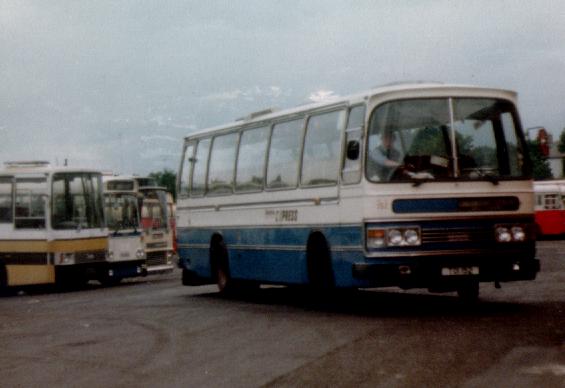
Duple Dominant bodied 152 seen in CIE's Broadstone garage on June 29th 1983, preparing to leave for
Busaras and return to Ulster on an express service, in the pre-Goldliner days.(Photo copyright Shane Conway)
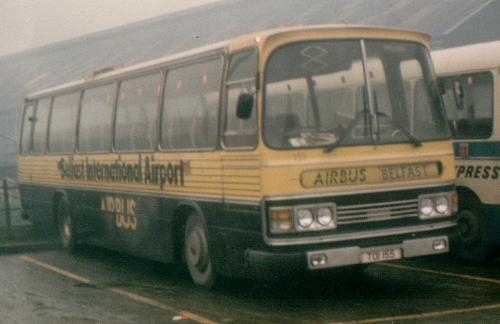
1979 Duple bodied 155 was one of a few coaches painted in this special livery for the Airbus service.
This view, taken on November 17th 1984, shows that most of the side chrome strips have been removed to make way for the signwriting.
(Photo copyright Shane Conway)
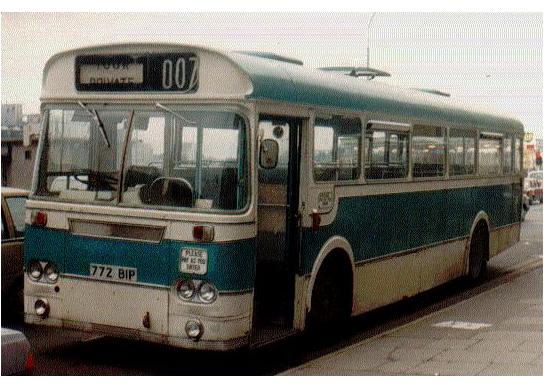
Of the batch of 25 F registered Southdown Leopards (170 to 194), Ulsterbus acquired 22 of them. One
of the three escapees was KCD 179F which instead made its way to County Kilkenny in 1979 to become Suir Valley's 772 BIP, and was
photographed in Waterford on October 13th 1984.(Photo copyright Shane Conway)
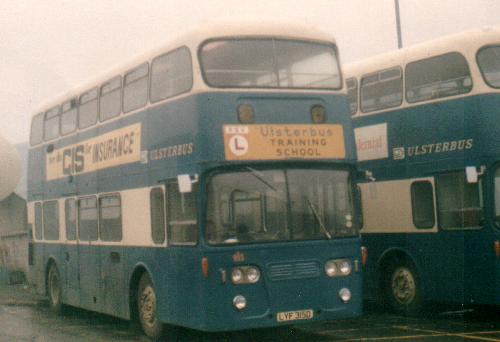
One of four Atlanteans acquired from British Airways in 1979, LYF 315D has Alexander styled MCW
bodywork. Note the emergency door ahead of the rear axle, as originally these vehicles had a luggage compartment at the back of the
lower saloon.(Photo copyright Shane Conway)
- 134 ROI 134 Leyland PSU3E/4R 7802589 - Alexander (B) DP49F 360/35 new 2/1979; r/r FEZ 8165 11/2005; w/d 12/2005 and sold for scrap 5/2006
- 138 ROI 138 Leyland PSU3E/4R 7803042 - Alexander (B) DP49F 360/43 new 2/1979; destroyed in Dromore 9/1994 and sold for scrap 9/1994
- 139 ROI 139 Leyland PSU3E/4R 7803048 - Alexander (B) DP49F 360/45 new 3/1979; r/r EEZ 6838 8/2005; w/d 6/2006 and sold for scrap 8/2006
- 141 ROI 141 Leyland PSU3E/4R 7803059 - Alexander (B) DP49F 360/44 new 4/1979; r/r EEZ 6784 8/2005; w/d 1/2006 and sold for scrap 6/2006
- 142 ROI 142 Leyland PSU3E/4R 7803322 - Alexander (B) DP49F 360/42 new 2/1979; w/d 11/1999 and sold for scrap 1/2001
- 144 ROI 144 Leyland PSU3E/4R 7803452 - Alexander (B) DP49F 360/46 new 5/1979; destroyed in Lurgan 3/1999 and sold for scrap 3/1999
- 145 ROI 145 Leyland PSU3E/4R 7803794 - Alexander (B) DP49F 360/38 new 1/1979; r/r FEZ 8164 11/2005; w/d 6/2006 and sold for scrap 8/2006
- 148 ROI 148 Leyland PSU3E/4R 7803796 - Alexander (B) DP49F 360/40 new 1/1979; r/r GEZ 1244 12/2005; w/d 12/2005 and sold for scrap 5/2006
- 149 ROI 149 Leyland PSU3E/4R 7803319 - Alexander (B) DP49F 360/39 new 1/1979; w/d 6/2001 and sold for scrap 2/2004
- 150 ROI 150 Leyland PSU3E/4R 7803354 - Alexander (B) DP49F 360/41 new 1/1979; w/d 10/2000; r/r HCZ 1886 11/2000 and sold for scrap 10/2001
-
- 151 TOI 151 Leyland PSU3E/4R 7805477 - Duple C53F 933/5123 new 6/1979; to TCT, Carraroe 10/1990; sold for scrap by 3/1998
- 152 TOI 152 Leyland PSU3E/4R 7805500 - Duple C53F 933/5122 new 6/1979; w/d 6/1987 and sold for scrap 10/1990
- 153 TOI 153 Leyland PSU3E/4R 7805769 - Duple C53F 933/5120 new 5/1979; w/d 6/1987; to TCT, Carraroe 7/1990; sold for scrap by 3/1998
- 154 TOI 154 Leyland PSU3E/4R 7805593 - Duple C53F 933/5121 new 5/1979; destroyed in Aughnacloy 8/1979 and sold for scrap 10/1979
- 155 TOI 155 Leyland PSU3E/4R 7805790 - Duple C53F 933/5124 new 7/1979; w/d 5/1987; to TCT, Carraroe 6/1990; sold for scrap by 3/1998
- 156 TOI 156 Leyland PSU3E/4R 7805766 - Duple C53F 933/5125 new 6/1979; destroyed in Armagh 4/1982 and sold for scrap 8/1982
-
- 951 LYF 306D Leyland PDR1/201 L60308 - MCW CH18/2016F new 10/1966 (to British Overseas Airways Corporation); ex British Airways 4/1979; reseated to H40/29F 4/1979; destroyed in Omagh 3/1983 and sold for scrap 3/1984
- 952 LYF 312D Leyland PDR1/201 L61410 - MCW CH18/2016F new 10/1966 (to British Overseas Airways Corporation); ex British Airways 4/1979; reseated to H40/29F 4/1979; destroyed in Omagh 7/1982 and sold for scrap 12/1982
- 953 LYF 315D Leyland PDR1/201 L62517 - MCW CH18/2016F new 11/1966 (to British Overseas Airways Corporation); ex British Airways 4/1979; reseated to H40/29F 4/1979; used as driver trainer 9/1983 to 10/1985; w/d 10/1985 and sold for scrap 11/1987
- 954 LYF 318D Leyland PDR1/201 L62829 - MCW CH18/2016F new 11/1966 (to British Overseas Airways Corporation); ex British Airways 4/1979; reseated to H40/29F 4/1979; used as driver trainer 9/1983 to 2/1987; w/d 2/1987 and sold for scrap by 12/1987
-
- 1141 CRN 818D Leyland PSU3/4R L43193 - Marshall DP49F B3516 new 4/1966; ex Ribble 818 7/1979; reseated to B49F ?/??; w/d 2/1985 and sold for scrap 10/1985
- 1142 CRN 819D Leyland PSU3/4R L43194 - Marshall DP49F B3517 new 4/1966; ex Ribble 819 7/1979; loaned to Citybus from 2/1980 to 4/1980; w/d 3/1981 and sold for scrap 6/1981
- 1143 CRN 821D Leyland PSU3/4R L43385 - Marshall DP49F B3520 new 4/1966; ex Ribble 821 7/1979; w/d 3/1981 and sold for scrap 6/1981
- 1144 CRN 822D Leyland PSU3/4R L43411 - Marshall DP49F B3519 new 4/1966; ex Ribble 822 7/1979; reseated to B49F ?/??; destroyed in Derry 6/1981 and sold for scrap 6/1981
- 1145 CRN 824D Leyland PSU3/4R L43508 - Marshall DP49F B3521 new 4/1966; ex Ribble 824 7/1979; loaned to Citybus from 2/1980 to 4/1980; destroyed in Derry 3/1982 and sold for scrap ?/??
- 1146 CRN 827D Leyland PSU3/4R L43528 - Marshall DP49F B3524 new 4/1966; ex Ribble 827 7/1979; loaned to Citybus from 2/1980 to 4/1980; w/d 6/1983; to Newall, Belfast 7/1984 for preservation; to Cassidy, Scotstown by 9/1986; gone by 7/1990
- 1147 CRN 828D Leyland PSU3/4R L43623 - Marshall DP49F B3526 new 4/1966; ex Ribble 828 7/1979; reseated to B49F ?/??; destroyed in Derry 4/1982 and sold for scrap 7/1982
- 1148 CRN 829D Leyland PSU3/4R L43624 - Marshall DP49F B3527 new 4/1966; ex Ribble 829 7/1979; reseated to B49F ?/??; destroyed in Derry 7/1981 and sold for scrap ?/??
- 1149 CRN 830D Leyland PSU3/4R L43719 - Marshall DP49F B3528 new 4/1966; ex Ribble 830 7/1979; w/d following accident 12/1981 and sold for scrap 7/1982
- 1150 CRN 831D Leyland PSU3/4R L43720 - Marshall DP49F B3529 new 4/1966; ex Ribble 831 7/1979; destroyed in Derry 4/1982 and sold for scrap 7/1982
- ------- CRN 820D Leyland PSU3/4R L43384 - Marshall DP49F B3518 new 4/1966; ex Ribble 820 7/1979; not used and sold for scrap 1/1981
- ------- CRN 826D Leyland PSU3/4R L43527 - Marshall DP49F B3523 new 4/1966; ex Ribble 826 7/1979; not used and sold for scrap 1/1981
-
- 1168 HCD 766E Leyland PSU3/3RT 700148 - Marshall B53F B3759 new 7/1967; ex Southdown 166 9/1979; w/d 11/1981 and gone ?/??
- 1169 KCD 170F Leyland PSU3/3RT 700150 - Marshall B53F B3767 new 9/1967; ex Southdown 170 9/1979; w/d 12/1980 and sold for scrap 4/1983
- 1170 KCD 172F Leyland PSU3/3RT 700384 - Marshall B53F B3765 new 10/1967; ex Southdown 172 9/1979; w/d 10/1980 and sold for scrap 1/1981
- 1171 KCD 176F Leyland PSU3/3RT 700482 - Marshall B53F B3771 new 10/1967; ex Southdown 176 9/1979; w/d 1/1981 and sold for scrap 1/1982
- 1172 KCD 177F Leyland PSU3/3RT 700483 - Marshall B53F B3769 new 9/1967; ex Southdown 177 9/1979; w/d 11/1981 and sold for scrap 3/1985
- 1173 KCD 178F Leyland PSU3/3RT 700592 - Marshall B53F B3772 new 9/1967; ex Southdown 178 9/1979; not used and sold for scrap 12/1980
- 1174 KCD 180F Leyland PSU3/3RT 700594 - Marshall B53F B3774 new 10/1967; ex Southdown 180 9/1979; w/d 11/1981 and sold for scrap 2/1985
- 1175 KCD 181F Leyland PSU3/3RT 700783 - Marshall B53F B3776 new 10/1967; ex Southdown 181 9/1979; w/d 10/1981 and sold for scrap 8/1982
- 1176 KCD 182F Leyland PSU3/3RT 700784 - Marshall B53F B3781 new 10/1967; ex Southdown 182 9/1979; destroyed in Ballymoney 6/1981 and sold for scrap 7/1981
- 1177 KCD 183F Leyland PSU3/3RT 700855 - Marshall B53F B3784 new 10/1967; ex Southdown 183 9/1979; w/d 10/1981 and sold for scrap 8/1982
- 1178 KCD 184F Leyland PSU3/3RT 700786 - Marshall B53F B3777 new 10/1967; ex Southdown 184 9/1979; w/d 11/1981; used as storeshed at Magherafelt and sold for scrap 11/1985
- 1179 KCD 185F Leyland PSU3/3RT 700989 - Marshall B53F B3782 new 10/1967; ex Southdown 185 9/1979; w/d 6/1983 and sold for scrap 2/1985
- 1180 KCD 186F Leyland PSU3/3RT 700990 - Marshall B53F B3779 new 10/1967; ex Southdown 186 9/1979; w/d 3/1981 and sold for scrap 6/1981
- 1181 KCD 187F Leyland PSU3/3RT 701193 - Marshall B53F B3778 new 10/1967; ex Southdown 187 9/1979; w/d 9/1981 and sold for scrap 1/1982
- 1182 KCD 188F Leyland PSU3/3RT 701194 - Marshall B53F B3785 new 10/1967; ex Southdown 188 9/1979; w/d 1/1981 and sold for scrap 1/1982
- 1183 KCD 193F Leyland PSU3/3RT 701252 - Marshall B53F B3788 new 10/1967; ex Southdown 193 9/1979; destroyed in Derry 7/1981 and gone ?/??
- 1184 KUF 203F Leyland PSU3/3R 703472 - Willowbrook B53F CF1608 new 2/1968; ex Southdown 203 9/1979; w/d 11/1980; to Lough Swilly 204 12/1980; w/d 4/1987 and sold for scrap by 8/1988
- 1185 KUF 204F Leyland PSU3/3R 703473 - Willowbrook B53F CF1607 new 2/1968; ex Southdown 204 9/1979; w/d 11/1981 and sold for scrap 2/1985
- 1186 KUF 205F Leyland PSU3/3R 703573 - Willowbrook B53F CF1609 new 2/1968; ex Southdown 205 9/1979; w/d 2/1981 and sold for scrap 8/1982
- 1187 EUF 141D Leyland PSU3/201R L42516 - Weymann B53F M1731 new 12/65; ex Southdown 141 3/1979; w/d 11/1980; to Lough Swilly 205 12/1980; w/d 2/1984; used as towbus from 4/1984 and sold for scrap 7/1991
- 1188 EUF 142D Leyland PSU3/201R L42517 - Weymann B53F M1737 new 12/65; ex Southdown 142 3/1979; w/d 1/1981 and sold for scrap 2/1985
- 1189 EUF 145D Leyland PSU3/201R L42696 - Weymann B53F M1743 new 1/1966; ex Southdown 145 3/1979; w/d 2/1981 and sold for scrap 2/1985
- 1190 HUF 765E Leyland PSU3/3RT 700147 - Marshall B53F B3755 new 6/1967; ex Southdown 165 3/1979; w/d 2/1981 and sold for scrap 8/1982
- 1191 HUF 767E Leyland PSU3/3RT 700149 - Marshall B53F B3763 new 7/1967; ex Southdown 167 3/1979; w/d 6/1982 and sold for scrap 2/1985
- 1192 HUF 768E Leyland PSU3/3RT 700237 - Marshall B53F B3764 new 7/1967; ex Southdown 168 3/1979; w/d 6/1982 and sold for scrap 2/1985
- 1193 HUF 769E Leyland PSU3/3RT 700238 - Marshall B53F B3762 new 7/1967; ex Southdown 169 3/1979; w/d 6/1982 and sold for scrap 3/1985
- 1194 KCD 173F Leyland PSU3/3RT 700385 - Marshall B53F B3768 new 9/1967; ex Southdown 173 3/1979; w/d 2/1981 and sold for scrap 6/1982
- 1195 KCD 174F Leyland PSU3/3RT 700386 - Marshall B53F B3770 new 9/1967; ex Southdown 174 3/1979; w/d 11/1980 and sold for scrap 3/1981
- 1196 KCD 175F Leyland PSU3/3RT 700481 - Marshall B53F B3773 new 9/1967; ex Southdown 175 3/1979; destroyed in Ballycastle 5/1981 and sold for scrap 6/1981
- 1197 KCD 189F Leyland PSU3/3RT 701195 - Marshall B53F B3787 new 10/1967; ex Southdown 189 3/1979; w/d 3/1981 and sold for scrap 8/1982
- 1198 KCD 190F Leyland PSU3/3RT 701206 - Marshall B53F B3780 new 10/1967; ex Southdown 190 3/1979; w/d 5/1981 and sold for scrap 8/1982
- 1199 KCD 191F Leyland PSU3/3RT 701207 - Marshall B53F B3783 new 10/1967; ex Southdown 191 3/1979; destroyed in Derry 7/1981 and sold for scrap ?/??
-
- 1996 TOI 1996 Leyland PSU3E/4R 7805590 - Duple C53F 933/5183 new 6/1979; w/d 12/1992; to Chambers, Moneymore 4/1993; to O'Donnell, Manorcunningham 1993; r/r 79 DL 619 1993; ; to North West Busways, Moville by 8/1998 for spare parts; scrapped 12/2000
- 1997 TOI 1997 Leyland PSU3E/4R 7805598 - Duple C53F 933/5182 new 5/1979; destroyed in Pennyburn depot 31/2012/1992 and sold for scrap 6/1994
- 1998 TOI 1998 Leyland PSU3E/4R 7805817 - Duple C53F 933/5181 new 4/1979; destroyed in Antrim 10/1990 and sold for scrap 10/1990
- 1999 TOI 1999 Leyland PSU3E/4R 7805853 - Duple C53F 933/5180 new 4/1979; w/d ?/?? and sold for scrap 6/1994
-
- 2253 ROI 2253 Bristol RELL6G RELL-3-2336 - Alexander (B) B52F 341/66 new 2/1979; destroyed in Milewater Road yard 4/1986 and sold for scrap 6/1986
- 2254 ROI 2254 Bristol RELL6G RELL-3-2337 - Alexander (B) B52F 341/65 new 1/1979; w/d 10/1989; to Citybus 2254 10/1989; reseated to B51F 10/1989; w/d 10/1992; to Ulsterbus 2254 11/1993; w/d 6/2000 and sold for scrap 3/2001
- 2255 ROI 2255 Bristol RELL6G RELL-3-2338 - Alexander (B) B52F 341/67 new 1/1979; w/d 11/1999 and sold for scrap 11/2002
- 2256 ROI 2256 Bristol RELL6G RELL-3-2339 - Alexander (B) B52F 341/68 new 2/1979; w/d 6/2000 and sold for scrap 3/2001
- 2257 ROI 2257 Bristol RELL6G RELL-3-2340 - Alexander (B) B52F 341/69 new 2/1979; w/d 1/2000 and sold for scrap 3/2001
- 2258 ROI 2258 Bristol RELL6G RELL-3-2341 - Alexander (B) B52F 341/63 new 1/1979; w/d 6/2000 and sold for scrap 3/2001
- 2259 ROI 2259 Bristol RELL6G RELL-3-2342 - Alexander (B) B52F 341/64 new 1/1979; w/d 6/1999 and sold for scrap 1/2000
- 2260 ROI 2260 Bristol RELL6G RELL-3-2343 - Alexander (B) B52F 341/71 new 1/1979; w/d 2/1997 and sold for scrap 3/2002
- 2261 ROI 2261 Bristol RELL6G RELL-3-2344 - Alexander (B) B52F 341/75 new 2/1979; destroyed in Oxford Street 8/1982; rebodied Alexander (B) B52F 945/201 6/1983; w/d 6/1988; to Citybus 2261 7/1988; reseated to B51F 7/1988; destroyed (again) in Belfast 2/1992 and sold for scrap 2/1992
- 2262 ROI 2262 Bristol RELL6G RELL-3-2345 - Alexander (B) B52F 341/70 new 2/1979; destroyed in Oxford Street 5/1982; rebodied Alexander (B) B52F 754/2018 3/1983; w/d 9/1999 and sold for scrap 3/2001 (N.B. 754/2018 was originally intended to be fitted to bus 2597 - the latter then received body 945/2 instead and became the final RE to enter service)
- 2263 ROI 2263 Bristol RELL6G RELL-3-2346 - Alexander (B) B52F 341/74 new 3/1979; destroyed in Belfast 8/1988 and sold for scrap by 9/1993
- 2264 ROI 2264 Bristol RELL6G RELL-3-2347 - Alexander (B) B52F 341/80 new 3/1979; w/d ?/?? and sold for scrap 3/2002
- 2265 ROI 2265 Bristol RELL6G RELL-3-2348 - Alexander (B) B52F 341/72 new 2/1979; destroyed in Oxford Street 2/1986 and sold for scrap 4/1986
- 2266 ROI 2266 Bristol RELL6G RELL-3-2349 - Alexander (B) B52F 341/73 new 2/1979; w/d 11/1999 and sold for scrap 3/2001
- 2267 ROI 2267 Bristol RELL6G RELL-3-2350 - Alexander (B) B52F 341/81 new 3/1979; w/d 9/1999 and sold for scrap 3/2000 OR 4/2001
- 2268 ROI 2268 Bristol RELL6G RELL-3-2351 - Alexander (B) B52F 341/93 new 5/1979; w/d 4/2000 and sold for scrap 6/2002
- 2269 ROI 2269 Bristol RELL6G RELL-3-2352 - Alexander (B) B52F 341/90 new 5/1979; w/d 5/2000 and sold for scrap 4/2001
- 2270 ROI 2270 Bristol RELL6G RELL-3-2353 - Alexander (B) B52F 341/84 new 4/1979; w/d 1/1997 and sold for scrap 3/2002
- 2271 TOI 2271 Bristol RELL6G RELL-3-2354 - Alexander (B) B52F 341/82 new 3/1979; w/d 10/1990 following fire damage and sold for scrap 7/1991
- 2272 TOI 2272 Bristol RELL6G RELL-3-2355 - Alexander (B) B52F 341/83 new 4/1979; w/d 11/1999; to Lough Swilly 3/2004; stripped for spares and sold for scrap 8/2005
- 2273 TOI 2273 Bristol RELL6G RELL-3-2356 - Alexander (B) B52F 341/79 new 3/1979; w/d 1/2000 and sold for scrap 3/2002
- 2274 TOI 2274 Bristol RELL6G RELL-3-2357 - Alexander (B) B52F 341/77 new 3/1979; destroyed in Belfast 3/1988 and sold for scrap by 9/1993
- 2275 TOI 2275 Bristol RELL6G RELL-3-2358 - Alexander (B) B52F 341/86 new 5/1979; driver trainer 2/1990 to 4/1990; w/d 4/1992 following accident damage and sold for scrap by 2/1993
- 2276 TOI 2276 Bristol RELL6G RELL-3-2359 - Alexander (B) B52F 341/76 new 4/1979; w/d 12/1987; to Citybus 2276 12/1987; reseated to B51F 12/1987; w/d 4/1992; to Ulsterbus 2276 10/1993; w/d 10/1999 and sold for scrap 3/2002
- 2277 TOI 2277 Bristol RELL6G RELL-3-2360 - Alexander (B) B52F 341/89 new 4/1979; w/d 3/2000 and sold for scrap 3/2001
- 2278 TOI 2278 Bristol RELL6G RELL-3-2361 - Alexander (B) B52F 341/85 new 4/1979; destroyed in Ballymoney 6/1981 and sold for scrap 7/1981
- 2279 TOI 2279 Bristol RELL6G RELL-3-2362 - Alexander (B) B52F 341/92 new 5/1979; w/d 6/2000 and sold for scrap 6/2003
- 2280 TOI 2280 Bristol RELL6G RELL-3-2363 - Alexander (B) B52F 341/94 new 5/1979; w/d 6/2000; to Lockhart, Derry for spare parts by 2/2005
- 2281 TOI 2281 Bristol RELL6G RELL-3-2364 - Alexander (B) B52F 341/88 new 4/1979; w/d 3/2000 and sold for scrap 8/2002
- 2282 TOI 2282 Bristol RELL6G RELL-3-2365 - Alexander (B) B52F 341/91 new 5/1979; destroyed in Derry 11/1990 and sold for scrap by 2/1991
- 2283 TOI 2283 Bristol RELL6G RELL-3-2390 - Alexander (B) B52F 341/78 new 4/1979; w/d 3/2000 and sold for scrap 8/2002
- 2284 TOI 2284 Bristol RELL6G RELL-3-2391 - Alexander (B) B52F 341/87 new 4/1979; w/d 3/2000 and sold for scrap 6/2003
- 2285 TOI 2285 Bristol RELL6G RELL-3-2392 - Alexander (B) B52F 341/111 new 8/1979; w/d 6/2000 and sold for scrap ?/??
- 2286 TOI 2286 Bristol RELL6G RELL-3-2393 - Alexander (B) B52F 341/110 new 8/1979; destroyed in Derry 7/1997 and sold for scrap by 8/1997
- 2287 TOI 2287 Bristol RELL6G RELL-3-2394 - Alexander (B) B52F 341/115 new 10/1979; w/d 9/1987; to Citybus 2287 9/1987; reseated to B51F 9/1987; w/d 10/1992; to Ulsterbus 2287 10/1993; w/d 2/2000 and sold for scrap 3/2002
- 2288 TOI 2288 Bristol RELL6G RELL-3-2395 - Alexander (B) B52F 341/97 new 6/1979; w/d 9/1988; to Citybus 2288 9/1988; reseated to B51F 9/1988; w/d 4/1992; body sold for scrap by 8/1992 and chassis to Bristol Industrial Museum 1992 **SURVIVOR**
- 2289 TOI 2289 Bristol RELL6G RELL-3-2396 - Alexander (B) B52F 341/105 new 8/1979; w/d 9/1987; to Citybus 2289 9/1987; reseated to B51F 9/1987; destroyed in Falls Park 2/1991 and sold for scrap 2/1991
- 2290 TOI 2290 Bristol RELL6G RELL-3-2397 - Alexander (B) B52F 341/95 new 6/1979; w/d 5/1989; to Citybus 2290 5/1989; reseated to B51F 5/1989; w/d 10/1992; to Ulsterbus 2290 10/1993; w/d 2/2000 and sold for scrap 3/2001
- 2291 TOI 2291 Bristol RELL6G RELL-3-2398 - Alexander (B) B52F 341/100 new 7/1979; w/d 9/1989; to Citybus 2291 9/1989; reseated to B51F 9/1989; w/d 10/1992; to Ulsterbus 2291 10/1993; w/d 6/2000 and sold for scrap 3/2002
- 2292 TOI 2292 Bristol RELL6G RELL-3-2399 - Alexander (B) B52F 341/106 new 8/1979; w/d 6/2000 and sold for scrap 3/2001
- 2293 TOI 2293 Bristol RELL6G RELL-3-2400 - Alexander (B) B52F 341/96 new 5/1979; w/d 6/2000 and sold for scrap 4/2002
- 2294 TOI 2294 Bristol RELL6G RELL-3-2401 - Alexander (B) B52F 341/97 new 6/1979; w/d 6/2000 and sold for scrap 2/2004
- 2295 TOI 2295 Bristol RELL6G RELL-3-2402 - Alexander (B) B52F 341/109 new 8/1979; destroyed in Oxford Street 2/1986 and sold for scrap 4/1986
- 2296 TOI 2296 Bristol RELL6G RELL-3-2403 - Alexander (B) B52F 341/108 new 8/1979; w/d 2/1988; to Citybus 2296 2/1988; reseated to B51F 2/1988; destroyed in Belfast 10/1989 and sold for scrap ?/??
- 2297 TOI 2297 Bristol RELL6G RELL-3-2404 - Alexander (B) B52F 341/112 new 9/1979; w/d 10/1988; to Citybus 2297 10/1988; reseated to B51F 10/1988; w/d 10/1992; to Ulsterbus 2297 10/1993; w/d 1/2000 and sold for scrap 3/2002
- 2298 TOI 2298 Bristol RELL6G RELL-3-2405 - Alexander (B) B52F 341/101 new 8/1979; w/d 1/2000 and sold for scrap 3/2001
- 2299 TOI 2299 Bristol RELL6G RELL-3-2406 - Alexander (B) B52F 341/113 new 9/1979; w/d 10/1988; to Citybus 2299 10/1988; reseated to B51F 10/1988; w/d 10/1992; to Ulsterbus 2299 10/1993; w/d 1/2000 and sold for scrap 5/2002
- 2300 TOI 2300 Bristol RELL6G RELL-3-2407 - Alexander (B) B52F 341/102 new 7/1979; w/d 6/2000; r/r GCZ 6199 6/2000 and sold for scrap 3/2002
- 2301 TOI 2301 Bristol RELL6G RELL-3-2408 - Alexander (B) B52F 341/99 new 6/1979; w/d 9/1987; to Citybus 2301 9/1987; reseated to B51F 9/1987; w/d 7/1996; to Ulsterbus 2301 8/1996; w/d 6/2001 and sold for scrap 11/2003
- 2302 TOI 2302 Bristol RELL6G RELL-3-2409 - Alexander (B) B52F 341/114 new 9/1979; w/d 11/1999 and sold for scrap 6/2002
- 2303 TOI 2303 Bristol RELL6G RELL-3-2410 - Alexander (B) B52F 341/103 new 8/1979; destroyed in Swatragh 5/1981 and sold for scrap 7/1981 (first of batch to be withdrawn)
- 2304 TOI 2304 Bristol RELL6G RELL-3-2411 - Alexander (B) B52F 341/107 new 8/1979; w/d 7/1989; to Citybus 2304 7/1989; w/d 6/1994 and sold for scrap by 8/1995
- 2305 TOI 2305 Bristol RELL6G RELL-3-2412 - Alexander (B) B52F 341/104 new 8/1979; w/d 2/2001; to Lough Swilly 3/2004; stripped for spares and sold for scrap by 1/2006
-
- 2362 UOI 2362 Bristol RELL6G RELL-3-2469 - Alexander (B) B52F 561/5 new 11/1979; w/d 1/1988; to Citybus 2362 1/1988; reseated to B51F 1/1988; w/d 1/1997; to Ulsterbus 2362 1/1997; w/d 1/2003 and sold for scrap 7/2003
- 2363 UOI 2363 Bristol RELL6G RELL-3-2470 - Alexander (B) B52F 561/197 new 12/1979; w/d 11/1987; to Citybus 2363 11/1987; reseated to B51F 11/1987; w/d 10/1995 following accident damage and sold for scrap 3/1996
- 2364 UOI 2364 Bristol RELL6G RELL-3-2471 - Alexander (B) B52F 561/6 new 12/1979; destroyed in Oxford Street 4/1987 and sold for scrap 11/1987
- 2365 UOI 2365 Bristol RELL6G RELL-3-2472 - Alexander (B) B52F 561/3 new 12/1979; destroyed in Belfast 8/1988 and sold for scrap by 9/1993
- 2367 UOI 2367 Bristol RELL6G RELL-3-2474 - Alexander (B) B52F 561/1 new 12/1979; w/d 3/2003; to Nocton, Camborne 12/2004; to S & A Produce, Marden 4/2007; sold for scrap 7/2007
- 2368 UOI 2368 Bristol RELL6G RELL-3-2475 - Alexander (B) B52F 561/198 new 12/1979; w/d 3/2003; to Nocton, Camborne 12/2004; sold for scrap by 9/2007
- 2371 UOI 2371 Bristol RELL6G RELL-3-2478 - Alexander (B) B52F 561/4 new 12/1979; destroyed in Newry 3/1984 and sold for scrap 2/1985
- 2372 UOI 2372 Bristol RELL6G RELL-3-2479 - Alexander (B) B52F 561/2 new 12/1979; destroyed in Newry depot 29/2/1980 and sold for scrap 3/1980 (first of batch to be withdrawn, along with 2370)
Rebodied vehicles:
- 1592 TOI 3592 (COI 1420) Leyland PSU3A/4R UBLE717903 - Alexander (B) B53F 613/201 new 9/1979 as a rebuild of no. 1420; destroyed in Oxford Street 5/1982 and sold for scrap 3/1983
- 1664 SOI 6664 (FOI 1664) Bristol LH6L BLH737802 - Alexander (B) B45F 536/2 new 2/1979 as a rebuild of 1664; w/d 9/1988 and sold for scrap 9/1994
1980
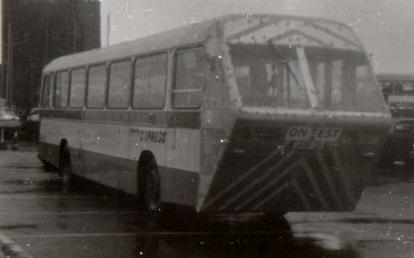
Leopard 179 was modified briefly in 1982 in connection with a University based aerodynamics research
project. It was seen at the ITT rally on May 1st at Carrickfergus.(Photo copyright Shane Conway)
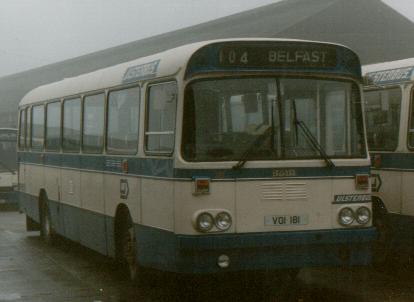
Great Victoria Street in February 1994 and Leopard 181 is in the revised livery with blue above the
windscreen and the fleetname above the windows.(Photo copyright Shane Conway)
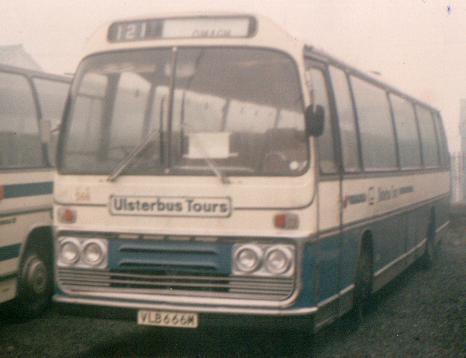
566 was one of three 12 metre Plaxton Elites acquired in 1980 from UK operators. Just visible
alongside is a later example of a Plaxton Supreme bodied Leopard. This photo was taken on November 17th 1984. (Photo copyright
Shane Conway)
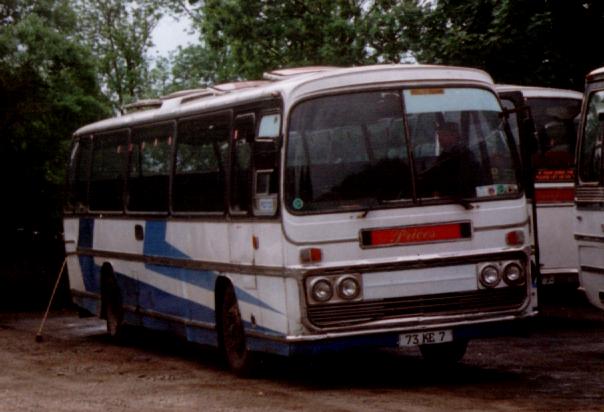
Following withdrawal by Ulsterbus, acquired coach 568 was sold to Price Coaches in Celbridge, County
Kildare where it was photographed on May 25th 1991.(Photo copyright Shane Conway)
- 157 UOI 9157 Leyland PSU3E/4R 7900189 - Alexander (B) DP49F 580/5 new 2/1980; destroyed in Armagh 6/1997 and sold for scrap 6/1997
- 158 UOI 9158 Leyland PSU3E/4R 7901733 - Alexander (B) DP49F 580/197 new 2/1980; w/d 5/2003 following accident damage and sold for scrap 2/2004
- 159 UOI 9159 Leyland PSU3E/4R 7901056 - Alexander (B) DP49F 580/11 new 2/1980; w/d 6/2005 and sold for scrap 9/2005
- 160 UOI 9160 Leyland PSU3E/4R 7903255 - Alexander (B) DP49F 580/198 new 2/1980; destroyed in Newry depot 29/2/1980 and sold for scrap 3/1980 (first of the batch to be withdrawn, after only ten days service)
- 161 UOI 9161 Leyland PSU3E/4R 7900531 - Alexander (B) DP49F 580/12 new 2/1980; w/d 1/2004 and sold for scrap 6/2005
- 162 UOI 9162 Leyland PSU3E/4R 7900212 - Alexander (B) DP49F 580/199 new 2/1980; w/d 6/2003 and sold for scrap 6/2005
- 163 UOI 9163 Leyland PSU3E/4R 7900209 - Alexander (B) DP49F 580/14 new 3/1980; w/d 9/2003; to Slevin, Monilea 2/2004 **SURVIVOR**
- 164 UOI 9164 Leyland PSU3E/4R 7901949 - Alexander (B) DP49F 580/6 new 2/1980; destroyed in Belfast 10/1989 and sold for scrap 10/1989
- 165 UOI 9165 Leyland PSU3E/4R 7903259 - Alexander (B) DP49F 580/3 new 2/1980; destroyed in Belfast 7/1997 and sold for scrap 7/1997
- 166 UOI 9166 Leyland PSU3E/4R 7903394 - Alexander (B) DP49F 580/4 new 2/1980; w/d 6/2006 and sold for scrap 8/2006
- 167 UOI 9167 Leyland PSU3E/4R 7903660 - Alexander (B) DP49F 580/2 new 1/1980; w/d 11/2005 and sold for scrap 5/2006
- 168 UOI 9168 Leyland PSU3E/4R 7903661 - Alexander (B) DP49F 580/1 new 1/1980; used as driver trainer 11/2003 to 5/2005; w/d 5/2005; donated to Asia Bus Response 6/2005 **SURVIVOR**
- 169 UOI 9169 Leyland PSU3E/4R 7903267 - Alexander (B) DP49F 580/15 new 3/1980; w/d 10/2003 and sold for scrap 3/2004
- 170 UOI 9170 Leyland PSU3E/4R 7902529 - Alexander (B) DP49F 580/10 new 2/1980; w/d 12/2005; to Haughey, Forkhill for preservation 2/2006; to Ulsterbus 170 8/2006; not used and sold for scrap 8/2006
-
- 171 VOI 171 Leyland PSU3E/4R 7901102 - Alexander (B) DP49F 580/17 new 3/1980; r/r GEZ 4766 2/2006; w/d 12/2005 and sold for scrap 6/2006
- 172 VOI 172 Leyland PSU3E/4R 7901774 - Alexander (B) DP49F 580/27 new 5/1980; used as driver trainer 9/2004 to 5/2005; w/d 5/2005; r/r DEZ 7907 6/2005; donated to Asia Bus Response 6/2005 **SURVIVOR**
- 173 VOI 173 Leyland PSU3E/4R 7900528 - Alexander (B) DP49F 580/13 new 3/1980; w/d 9/2003 and sold to Wealden PSV Sales 10/2003 **SURVIVOR**
- 174 VOI 174 Leyland PSU3E/4R 7900216 - Alexander (B) DP49F 580/19 new 4/1980; loaned to CIE 7/1984 to 8/1984; w/d 1/2006 and sold for scrap 8/2006
- 175 VOI 175 Leyland PSU3E/4R 7901516 - Alexander (B) DP49F 580/16 new 3/1980; loaned to CIE 7/1984 to 8/1984; w/d 2/2003 and sold for scrap 4/2003
- 176 VOI 176 Leyland PSU3E/4R 7900558 - Alexander (B) DP49F 580/20 new 4/1980; w/d 9/2003 and sold for scrap 5/2005
- 177 VOI 177 Leyland PSU3E/4R 7900848 - Alexander (B) DP49F 580/18 new 3/1980; r/r VCZ 8661 2/2004; w/d 4/2005 following accident and sold for scrap 8/2005
- 178 VOI 178 Leyland PSU3E/4R 7901500 - Alexander (B) DP49F 580/21 new 4/1980; w/d 6/2000 and sold for scrap 3/2001
- 179 VOI 179 Leyland PSU3E/4R 7901064 - Alexander (B) DP49F 580/22 new 4/1980; w/d 6/2006; r/r KEZ 4386 10/2006; sold for scrap 10/2006
- 180 VOI 180 Leyland PSU3E/4R 7901289 - Alexander (B) DP49F 580/24 new 4/1980; w/d 6/2003 and sold for scrap 5/2004
- 181 VOI 181 Leyland PSU3E/4R 7902029 - Alexander (B) DP49F 580/23 new 4/1980; w/d 11/2003; donated to Asia Bus Response 6/2005 **SURVIVOR**
- 182 VOI 182 Leyland PSU3E/4R 7902314 - Alexander (B) DP49F 580/28 new 5/1980; w/d 8/2003; r/r UCZ 1781 9/2003; to Thompson, Newtownards 10/2003 for preservation **SURVIVOR**
- 183 VOI 183 Leyland PSU3E/4R 7902032 - Alexander (B) DP49F 580/32 new 5/1980; used as driver trainer 9/2003 to 10/2003; w/d 10/2003 and sold for scrap 11/2003
- 184 VOI 184 Leyland PSU3E/4R 7901818 - Alexander (B) DP49F 580/30 new 5/1980; w/d 11/2005 and sold for scrap 6/2007
- 185 VOI 185 Leyland PSU3E/4R 7902311 - Alexander (B) DP49F 580/26 new 5/1980; reseated to B63F 2/1996; w/d 6/2003 and sold for scrap 5/2005
- 186 VOI 186 Leyland PSU3E/4R 7901787 - Alexander (B) DP49F 580/33 new 5/1980; r/r OCZ 4209 7/2002; used as driver trainer 8/2003; returned to PSV service; driver trainer 5/2005 to 11/2005; w/d 11/2005 and sold for scrap 5/2006
- 187 VOI 187 Leyland PSU3E/4R 7901952 - Alexander (B) DP49F 580/40 new 5/1980; w/d 11/2003; r/r LKZ 6715 2/2004; to Montgomery, Ballymena 9/2006 for spare parts
- 188 VOI 188 Leyland PSU3E/4R 7900601 - Alexander (B) DP49F 580/25 new 5/1980; r/r EEZ 6839 8/2005; w/d 11/2005 and sold for scrap 6/2006
- 189 VOI 189 Leyland PSU3E/4R 7901721 - Alexander (B) DP49F 580/29 new 5/1980; reseated to B62F 6/1997; w/d 11/2005; r/r GEZ 1277 1/2006; to McCall, Lockerbie 6/2006; to Terry Barker (Barkers Motors) near Wrexham 2021, sold 5/2023 to unknown owner, Fulbourn, Cambridgeshire **SURVIVOR**
- 190 VOI 190 Leyland PSU3E/4R 7902518 - Alexander (B) DP49F 580/31 new 6/1980; w/d 2/2004; r/r YCZ 6472 9/2004; sold for scrap 9/2004
- 191 VOI 191 Leyland PSU3E/4R 7901481 - Alexander (B) DP49F 580/48 new 8/1980; destroyed in Armagh 4/1982 and sold for scrap 8/1982 (first of the batch to be withdrawn)
- 192 VOI 192 Leyland PSU3E/4R 7901784 - Alexander (B) DP49F 580/35 new 6/1980; w/d 2/2004 following accident; r/r XCZ 4076 5/2004; sold for scrap 7/2005
- 193 VOI 193 Leyland PSU3E/4R 7901780 - Alexander (B) DP49F 580/37 new 6/1980; w/d 9/2003 and sold for scrap 5/2005
- 194 VOI 194 Leyland PSU3E/4R 7901939 - Alexander (B) DP49F 580/34 new 6/1980; w/d 10/2005; r/r FEZ 7736 11/2005; sold for scrap 6/2006
- 195 VOI 195 Leyland PSU3E/4R 7901941 - Alexander (B) DP49F 580/36 new 6/1980; w/d 9/2003; r/r UCZ 5421 10/2003; sold for scrap 6/2005
- 196 VOI 196 Leyland PSU3E/4R 7902246 - Alexander (B) DP49F 580/38 new 8/1980; destroyed in Belfast 4/1987 and sold for scrap 4/1987 (disposal not confirmed)
- 197 VOI 197 Leyland PSU3E/4R 7903396 - Alexander (B) DP49F 580/39 new 8/1980; destroyed in Lisburn 4/1986 and sold for scrap 6/1986
- 198 VOI 198 Leyland PSU3E/4R 7901947 - Alexander (B) DP49F 580/42 new 7/1980; r/r IEZ 1150 5/2006; w/d 6/2006 and sold for scrap 10/2006
- 199 VOI 199 Leyland PSU3E/4R 7902660 - Alexander (B) DP49F 580/47 new 8/1980; r/r KCZ 4583 8/2001; r/n 4199 4/2003; towbus from 3/2004; w/d 5/2012; to Davis, Kirk Michael 5/2012 for preservation **SURVIVOR**
- 200 VOI 200 Leyland PSU3E/4R 7903429 - Alexander (B) DP49F 580/44 new 7/1980; r/r EEZ 6782 8/2005; w/d 11/2005 and sold for scrap 5/2005
- 201 VOI 201 Leyland PSU3E/4R 7901946 - Alexander (B) DP49F 580/41 new 6/1980; w/d 5/2003 and sold for scrap by 1/2006
- 202 VOI 202 Leyland PSU3E/4R 7903313 - Alexander (B) DP49F 580/49 new 9/1980; destroyed in Newry 8/1988 and sold for scrap 9/1988
- 203 VOI 203 Leyland PSU3E/4R 7902643 - Alexander (B) DP49F 580/46 new 7/1980; r/r EEZ 7853 8/2005; w/d 10/2005 and sold for scrap 5/2005
- 204 VOI 204 Leyland PSU3E/4R 7902569 - Alexander (B) DP49F 580/50 new 9/1980; w/d 1/2006; r/r IEZ 1230 5/2006; sold for scrap 6/2006
- 205 VOI 205 Leyland PSU3E/4R 7903263 - Alexander (B) DP49F 580/43 new 7/1980; r/r EEZ 6785 8/2005; w/d 10/2005 and sold for scrap 5/2006
- 206 VOI 206 Leyland PSU3E/4R 7902025 - Alexander (B) DP49F 580/45 new 7/1980; w/d 11/2005; r/r GEZ 1252 12/2005 and sold for scrap 8/2006
-
- 566 VLB 666M Leyland PSU5/4R 7401492 - Plaxton C57F 7412LC009 new 4/1974; ex Grey Green, London 5/1980; w/d 7/1989 and used as store at Dromore; sold for scrap 9/1990
- 567 REW 987K Leyland PSU5/4R 7200768 - Plaxton C57F 729207 new 5/1972; ex S & M, Benfleet 4/1980; w/d 5/1985 and sold for scrap 4/1989
- 568 SHN 400L Leyland PSU5/4R 7203679 - Plaxton C57F 733116 new 6/1973; ex Wilkinson, Hebburn 4/1980; w/d 9/1986; to Price, Celbridge 6/1989; r/r 73 KE 7 6/1989; to Analiffey, Celbridge 5/1993; to T C T, Carraroe 5/1995; w/d and derelict by 5/1996
-
- 1129 DRN 661D Leyland PSU4/4R L62291 - Marshall B44F B3825 new 11/1966; ex Ribble 661 3/1980; not used and sold for scrap 3/1984
- 1130 DRN 666D Leyland PSU4/4R L62414 - Marshall B44F B3830 new 12/1966; ex Ribble 666 3/1980; destroyed in Derry 8/1983 and sold for scrap 8/1983
- 1131 DRN 667D Leyland PSU4/4R L62415 - Marshall B44F B3832 new 12/1966; ex Ribble 667 3/1980; w/d 4/1985; to McGrady Freight, Derry 5/1985
- 1132 DRN 670D Leyland PSU4/4R L62521 - Marshall B44F B3834 new 12/1966; ex Ribble 670 3/1980; not used and sold for scrap 2/1985
- 1133 DRN 674D Leyland PSU4/4R L62595 - Marshall B44F B3838 new 1/1967; ex Ribble 674 3/1980; used as staff bus 11/1981 to 4/1982; destroyed in Derry 2/1983 and sold for scrap 2/1985
- 1134 DRN 675D Leyland PSU4/4R L62596 - Marshall B44F B3839 new 1/1967; ex Ribble 675 3/1980; destroyed in Derry 3/1982 and sold for scrap ?/??
- 1135 DRN 677D Leyland PSU4/4R L62633 - Marshall B44F B3841 new 1/1967; ex Ribble 677 3/1980; destroyed in Derry 10/1981 and sold for scrap 7/1982
- 1136 DRN 678D Leyland PSU4/4R L62784 - Marshall B44F B3844 new 2/1967; ex Ribble 678 3/1980; destroyed 3/1982 and sold for scrap 7/1982
- 1137 DRN 679D Leyland PSU4/4R L62873 - Marshall B44F B3842 new 1/1967; ex Ribble 679 3/1980; destroyed in Derry 3/1982 and sold for scrap ?/??
- 1138 DRN 680D Leyland PSU4/4R L62874 - Marshall B44F B3843 new 2/1967; ex Ribble 680 3/1980; w/d 9/1982 and sold for scrap 7/1984
- 1139 DRN 681D Leyland PSU4/4R L63010 - Marshall B44F B3845 new 2/1967; ex Ribble 681 3/1980; not used and sold for scrap 7/1984
- 1140 DRN 682D Leyland PSU4/4R L63011 - Marshall B44F B3846 new 2/1967; ex Ribble 682 3/1980; destroyed in Derry 2/1983 and sold for scrap ?/??
-
- 1372 BJI 1372 Dodge KCU1N6055 340024 - Harkness B26F new -/1974; hired from Western Education and Library Board 11/1980 to 8/1981 to operate part of service 134 due to a temporary weight restriction on the route
-
- 2361 UOI 2361 Bristol RELL6G RELL-3-2468 - Alexander (B) B52F 561/13 new 1/1980; w/d 1/1988; to Citybus 2361 1/1988; reseated to B51F 1/1988; w/d 3/1995 and sold for scrap 7/1995
- 2366 UOI 2366 Bristol RELL6G RELL-3-2473 - Alexander (B) B52F 561/10 new 1/1980; w/d 9/1998 and sold for scrap 3/2002
- 2369 UOI 2369 Bristol RELL6G RELL-3-2476 - Alexander (B) B52F 561/20 new 5/1980; destroyed in Newry 12/1984 and sold for scrap 2/1985
- 2370 UOI 2370 Bristol RELL6G RELL-3-2477 - Alexander (B) B52F 561/9 new 1/1980; destroyed in Newry depot 29/2/1980 and sold for scrap 3/1980 (first of batch to be withdrawn, along with 2372)
- 2373 UOI 2373 Bristol RELL6G RELL-3-2480 - Alexander (B) B52F 561/15 new 2/1980; destroyed in Carrickfergus 7/1996 and sold for scrap 7/1996
- 2374 UOI 2374 Bristol RELL6G RELL-3-2481 - Alexander (B) B52F 561/21 new 5/1980; w/d 5/1989; to Citybus 2374 5/1989; reseated to B51F 5/1989; w/d 8/1996; to Ulsterbus 2374 9/1996; w/d 6/2003; to Wealden PSV Sales, Tonbridge 6/2004 **SURVIVOR**
- 2375 UOI 2375 Bristol RELL6G RELL-3-2482 - Alexander (B) B52F 561/16 new 1/1980; w/d 12/2000 and sold for scrap 1/2004
- 2376 UOI 2376 Bristol RELL6G RELL-3-2483 - Alexander (B) B52F 561/11 new 1/1980; w/d 6/2004; to Wealden PSV Sales, Tonbridge 9/2004; sold for preservation by 5/2006 **SURVIVOR**
- 2377 UOI 2377 Bristol RELL6G RELL-3-2484 - Alexander (B) B52F 561/18 new 3/1980; w/d 5/2001 and sold for scrap 2/2004
- 2378 UOI 2378 Bristol RELL6G RELL-3-2485 - Alexander (B) B52F 561/22 new 6/1980; w/d 6/2000 and sold for scrap 3/2003
- 2379 UOI 2379 Bristol RELL6G RELL-3-2486 - Alexander (B) B52F 561/12 new 1/1980; w/d 2/2000 and sold for scrap 3/2002
- 2380 UOI 2380 Bristol RELL6G RELL-3-2487 - Alexander (B) B52F 561/17 new 2/1980; w/d 6/2000 and sold for scrap 3/2002
- 2381 UOI 2381 Bristol RELL6G RELL-3-2488 - Alexander (B) B52F 561/19 new 5/1980; w/d 10/2003 and sold for scrap 3/2004
- 2382 UOI 2382 Bristol RELL6G RELL-3-2489 - Alexander (B) B52F 561/14 new 1/1980; w/d 11/1999 and sold for scrap by 8/2000
- 2383 UOI 2383 Bristol RELL6G RELL-3-2490 - Alexander (B) B52F 561/27 new 8/1980; reseated to B51F 3/1988; loaned to Citybus 3/1988 to 5/1988; w/d 5/1997 following accident damage and sold for scrap 8/1998
- 2384 UOI 2384 Bristol RELL6G RELL-3-2491 - Alexander (B) B52F 561/26 new 8/1980; w/d 6/2000 and sold for scrap 8/2002
- 2385 UOI 2385 Bristol RELL6G RELL-3-2492 - Alexander (B) B52F 561/24 new 6/1980; w/d 10/2003; to Nocton, Camborne 12/2004; to S & A, Marden by 10/2008 **SURVIVOR**
- 2386 UOI 2386 Bristol RELL6G RELL-3-2493 - Alexander (B) B52F 561/25 new 7/1980; w/d 6/2001; to Glasgow Bus Museum 1/2002 **SURVIVOR**
- 2387 UOI 2387 Bristol RELL6G RELL-3-2494 - Alexander (B) B52F 561/29 new 9/1980; w/d 6/1989; to Citybus 2387 7/1989; reseated to B51F 7/1989; w/d 8/1996; to Ulsterbus 2387 9/1996; w/d 5/2000 and sold for scrap by 1/2002
- 2388 UOI 2388 Bristol RELL6G RELL-3-2495 - Alexander (B) B52F 561/28 new 8/1980; w/d 7/1989; to Citybus 2388 7/1989; reseated to B51F 7/1989; w/d 8/1996; to Ulsterbus 2388 8/1996; w/d 5/1997 and sold for scrap 5/1998
- 2389 UOI 2389 Bristol RELL6G RELL-3-2496 - Alexander (B) B52F 561/31 new 11/1980; w/d 2/2001 and sold for scrap 6/2002
- 2390 UOI 2390 Bristol RELL6G RELL-3-2497 - Alexander (B) B52F 561/30 new 9/1980; w/d 8/1989; to Citybus 2390 9/1989; reseated to B51F 9/1989; w/d 8/1996; to Ulsterbus 2390 9/1996; w/d 10/2003; to Hart, York 11/2003 **SURVIVOR** Preserved as Ulsterbus 2390
- 2391 UOI 2391 Bristol RELL6G RELL-3-2498 - Alexander (B) B52F 561/32 new 11/1980; w/d 10/1989; to Citybus 2391 10/1989; reseated to B51F 10/1989; w/d by 4/1997 and sold for scrap 4/1997
- 2392 UOI 2392 Bristol RELL6G RELL-3-2499 - Alexander (B) B52F 561/33 new 11/1980; destroyed in Coleraine 1/1996 and sold for scrap 3/2002
- 2393 UOI 2393 Bristol RELL6G RELL-3-2500 - Alexander (B) B52F 561/23 new 6/1980; w/d 11/1989; to Citybus 2393 11/1989; reseated to B51F 11/1989; w/d 1/1997 and sold for scrap 4/1997
- 2394 UOI 2394 Bristol RELL6G RELL-3-2525 - Alexander (B) B52F 561/35 new 11/1980; w/d 11/1989; to Citybus 2394 11/1989; reseated to B51F 11/1989; destroyed in Belfast 3/1990 and sold for scrap by 6/1990
- 2395 UOI 2395 Bristol RELL6G RELL-3-2526 - Alexander (B) B52F 563/4 new 11/1980; w/d 12/2003; to Andrews, South Mimms 7/2003; to Able Coaches, Edgware ?/??; to Andrews, South Mimms ?/??; to Nash, Ockley 9/2006 for preservation; to Mulpeter, Brighton 7/2010; to unknown, Tonbridge 10/2010 as motorhome **SURVIVOR**
- 2396 UOI 2396 Bristol RELL6G RELL-3-2527 - Alexander (B) B52F 561/34 new 10/1980; destroyed in Ballymoney 6/1981 and sold for scrap 7/1981
- 2397 UOI 2397 Bristol RELL6G RELL-3-2528 - Alexander (B) B52F 563/1 new 10/1980; w/d 11/2003; to Wealden PSV Sales, Tonbridge 9/2004 **SURVIVOR**
- 2398 UOI 2398 Bristol RELL6G RELL-3-2529 - Alexander (B) B52F 563/5 new 11/1980; w/d 9/2000 and sold for scrap 3/2002
- 2399 UOI 2399 Bristol RELL6G RELL-3-2530 - Alexander (B) B52F 563/7 new 11/1980; w/d 6/2000 and sold for scrap 6/2005
- 2400 UOI 2400 Bristol RELL6G RELL-3-2531 - Alexander (B) B52F 563/3 new 11/1980; w/d 10/2003; to Wealden PSV Sales, Tonbridge 7/2004 **SURVIVOR**
-
- 2431 WOI 2431 Bristol RELL6G RELL-3-2588 - Alexander (B) B52F 563/13 new 12/1980; w/d 2/1991; to Citybus 2431 3/1991; reseated to B51F 3/1991; w/d 5/1998; to Ulsterbus 2431 5/1998; w/d 5/2000; used as storeshed at Great Victoria Street from 5/2000; r/n 4431 9/2006; sold for scrap 11/2006
- 2432 WOI 2432 Bristol RELL6G RELL-3-2589 - Alexander (B) B52F 563/8 new 12/1980; w/d 2/2004; to Wealden PSV Sales, Tonbridge 10/2004 **SURVIVOR**
- 2433 WOI 2433 Bristol RELL6G RELL-3-2590 - Alexander (B) B52F 563/6 new 11/1980; w/d 11/1988; to Citybus 2433 11/1988; reseated to B51F 11/1988; w/d 5/1998; to Ulsterbus 2433 5/1998; w/d 5/2001 and sold for scrap 3/2002
- 2434 WOI 2434 Bristol RELL6G RELL-3-2591 - Alexander (B) B52F 563/2 new 11/1980; w/d 10/1990; to Citybus 2434 11/1990; reseated to B51F 11/1990; w/d 3/1997 and sold for scrap 12/1997
- 2435 WOI 2435 Bristol RELL6G RELL-3-2592 - Alexander (B) B52F 563/9 new 11/1980; w/d 11/1999 and sold for scrap 4/2000 OR 3/2001
- 2436 WOI 2436 Bristol RELL6G RELL-3-2593 - Alexander (B) B52F 563/10 new 12/1980; w/d 12/2001 and sold for scrap 6/2003
- 2437 WOI 2437 Bristol RELL6G RELL-3-2594 - Alexander (B) B52F 563/15 new 12/1980; w/d 6/2001 and sold for scrap 7/2005
- 2438 WOI 2438 Bristol RELL6G RELL-3-2595 - Alexander (B) B52F 563/11 new 12/1980; w/d 11/2003; to Challands, Selston 11/2003 **SURVIVOR** Preserved
- 2441 WOI 2441 Bristol RELL6G RELL-3-2598 - Alexander (B) B52F 563/12 new 12/1980; w/d 12/2003; to Lockhart, Derry 2/2004 **SURVIVOR** Preserved
- 2446 WOI 2446 Bristol RELL6G RELL-3-2603 - Alexander (B) B52F 563/14 new 12/1980; w/d 2/1991; to Citybus 2446 3/1991; reseated to B51F 3/1991; w/d 2/1997; to Belfast Royal Academy 11/1997; to Citybus 2446 6/2005; to Simpson, Bangor 8/2005 for preservation; to Nogues, Bangor 2/2012 for preservation **SURVIVOR**
1981
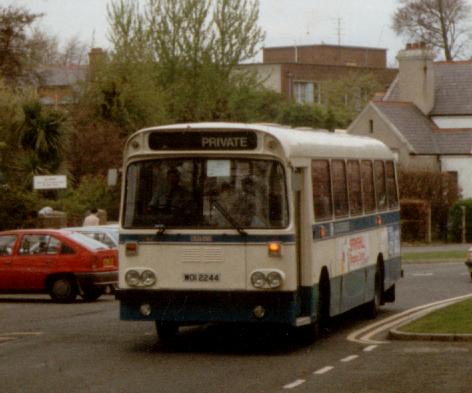
244 was new in 1981 and was visually very similar to the first batch of Leopards, which were new in
1968. 244 was taking part in the 1990 ITT rally on April 28th.(Photo copyright Shane Conway)
- 207 WOI 2207 Leyland PSU3E/4R 8030015 - Alexander (B) B53F 717/1 new 1/1981; w/d 5/1997 following accident and gone by 12/1999
- 208 WOI 2208 Leyland PSU3E/4R 8030017 - Alexander (B) B53F 717/2 new 1/1981; loaned to Citybus 5/1999; w/d 1/2006 and sold for scrap 6/2006
- 209 WOI 2209 Leyland PSU3E/4R 8030018 - Alexander (B) B53F 717/9 new 2/1981; driver trainer 5/2005 to 10/2005; w/d 10/2005; to Derry Limos by 11/2006 **SURVIVOR**
- 210 WOI 2210 Leyland PSU3E/4R 8030033 - Alexander (B) B53F 717/4 new 1/1981; w/d 1/2006 and sold for scrap 8/2006
- 211 WOI 2211 Leyland PSU3E/4R 8030049 - Alexander (B) B53F 717/5 new 1/1981; w/d 3/2006; to Curry, Pinxton 10/2006 for preservation; to Poots, Tandragee 8/2007 for preservation **SURVIVOR**
- 212 WOI 2212 Leyland PSU3E/4R 8030069 - Alexander (B) B53F 717/6 new 1/1981; w/d 5/2005 and donated to Asia Bus Response 6/2005 **SURVIVOR**
- 213 WOI 2213 Leyland PSU3E/4R 8030070 - Alexander (B) B53F 717/7 new 2/1981; w/d 6/2006 and sold for scrap 8/2006
- 214 WOI 2214 Leyland PSU3E/4R 8030019 - Alexander (B) B53F 717/10 new 2/1981; w/d 12/2005 and sold for scrap 10/2006
- 215 WOI 2215 Leyland PSU3E/4R 8030114 - Alexander (B) B53F 717/8 new 2/1981; destroyed in Dungiven 7/1996 and sold for scrap by 7/1997
- 216 WOI 2216 Leyland PSU3E/4R 8030122 - Alexander (B) B53F 717/18 new 7/1981; destroyed in Armagh 4/1982 and sold for scrap 8/1982
- 217 WOI 2217 Leyland PSU3E/4R 8030123 - Alexander (B) B53F 717/11 new 5/1981; w/d 6/2006; r/r IEZ 8825 7/2006 and sold for scrap 8/2006
- 218 WOI 2218 Leyland PSU3E/4R 8030124 - Alexander (B) B53F 717/13 new 9/1981; w/d 12/2005 and sold for scrap 8/2006
- 219 WOI 2219 Leyland PSU3E/4R 8030131 - Alexander (B) B53F 717/14 new 9/1981; w/d 1/2006 and sold for scrap 6/2006
- 220 WOI 2220 Leyland PSU3E/4R 8030132 - Alexander (B) B53F 717/12 new 6/1981; w/d 6/2006 and sold for scrap 8/2006
- 221 WOI 2221 Leyland PSU3E/4R 8030334 - Alexander (B) B53F 717/15 new 6/1981; w/d 11/2005; auctioned 2/2006 **SURVIVOR**new owner not yet identified
- 222 WOI 2222 Leyland PSU3E/4R 8030358 - Alexander (B) B53F 717/16 new 6/1981; w/d 3/2003; r/r SCZ 5505 3/2003??; sold for scrap 4/2003
- 223 WOI 2223 Leyland PSU3E/4R 8030368 - Alexander (B) B53F 717/3 new 2/1981; w/d 5/2006 and sold for scrap 10/2006
- 224 WOI 2224 Leyland PSU3E/4R 8030615 - Alexander (B) B53F 717/19 new 11/1981; w/d 12/2005 and sold for scrap 5/2006
- 225 WOI 2225 Leyland PSU3E/4R 8030616 - Alexander (B) B53F 717/20 new 9/1981; w/d 10/2005 and sold for scrap 6/2006
- 226 WOI 2226 Leyland PSU3E/4R 8030741 - Alexander (B) B53F 717/17 new 9/1981; w/d 6/2006 and sold for scrap 8/2006
-
- 227 WOI 2227 Leyland PSU3E/4R 8030074 - Alexander (B) DP49F 700/1 new 2/1981; w/d 6/2006 and sold for scrap 8/2006
- 228 WOI 2228 Leyland PSU3E/4R 8030075 - Alexander (B) DP49F 700/2 new 2/1981; destroyed in Cushendall 1/2002 and sold for scrap by 1/2006
- 229 WOI 2229 Leyland PSU3E/4R 8030076 - Alexander (B) DP49F 700/3 new 2/1981; w/d 11/2005 and sold for scrap 6/2006
- 230 WOI 2230 Leyland PSU3E/4R 8030083 - Alexander (B) DP49F 700/4 new 2/1981; w/d 11/2005 and sold for scrap 5/2006
- 231 WOI 2231 Leyland PSU3E/4R 8030084 - Alexander (B) DP49F 700/5 new 3/1981; destroyed in Strabane 8/1989 and sold for scrap 9/1989
- 232 WOI 2232 Leyland PSU3E/4R 8030098 - Alexander (B) DP49F 700/6 new 3/1981; w/d 6/2005 and sold for scrap 10/2005
- 233 WOI 2233 Leyland PSU3E/4R 8030099 - Alexander (B) DP49F 700/7 new 3/1981; w/d 5/2004 and sold for scrap 8/2005
- 234 WOI 2234 Leyland PSU3E/4R 8030100 - Alexander (B) DP49F 700/9 new 4/1981; destroyed in Belleek 5/1981 and sold for scrap ?/?? (first of the batch to be withdrawn)
- 235 WOI 2235 Leyland PSU3E/4R 8030103 - Alexander (B) DP49F 700/8 new 3/1981; w/d 5/1991; to Express Aid, Belfast 5/1991; to Johnston, Belfast 5/2000; to Gilmore and Thompson, Newtownards 9/2003; to Thompson, Newtownards 1/2006 for preservation **SURVIVOR**
- 236 WOI 2236 Leyland PSU3E/4R 8030104 - Alexander (B) DP49F 700/10 new 3/1981; w/d by 5/2006 and sold for scrap 5/2006
- 237 WOI 2237 Leyland PSU3E/4R 8030107 - Alexander (B) DP49F 700/12 new 4/1981; w/d 6/2006 and sold for scrap 10/2006
- 238 WOI 2238 Leyland PSU3E/4R 8030159 - Alexander (B) DP49F 700/11 new 4/1981; w/d 11/2005 and sold for scrap 5/2006
- 239 WOI 2239 Leyland PSU3E/4R 8030160 - Alexander (B) DP49F 700/14 new 4/1981; w/d 12/2005 and sold for scrap 8/2006
- 240 WOI 2240 Leyland PSU3E/4R 8030168 - Alexander (B) DP49F 700/15 new 4/1981; w/d 6/2006 and sold for scrap 10/2006
- 241 WOI 2241 Leyland PSU3E/4R 8030249 - Alexander (B) DP49F 700/16 new 4/1981; w/d 9/2003 following accident and sold for scrap 3/2004
- 242 WOI 2242 Leyland PSU3E/4R 8030267 - Alexander (B) DP49F 700/13 new 4/1981; w/d 6/2006 and sold for scrap 7/2006
- 243 WOI 2243 Leyland PSU3E/4R 8030372 - Alexander (B) DP49F 700/17 new 4/1981; w/d 8/2005 and sold for scrap 1/2006
- 244 WOI 2244 Leyland PSU3E/4R 8030374 - Alexander (B) DP49F 700/18 new 4/1981; w/d 6/2006 and sold for scrap 10/2006
- 245 WOI 2245 Leyland PSU3E/4R 8030401 - Alexander (B) DP49F 700/19 new 5/1981; w/d 2/2006 and sold for scrap 8/2006
- 246 WOI 2246 Leyland PSU3E/4R 8030402 - Alexander (B) DP49F 700/20 new 5/1981; destroyed in Milewater Road yard 4/1986 and sold for scrap 6/1986
- 247 WOI 2247 Leyland PSU3E/4R 8030406 - Alexander (B) DP49F 700/22 new 5/1981; w/d 1/2006 and sold for scrap 10/2006
- 248 WOI 2248 Leyland PSU3E/4R 8030407 - Alexander (B) DP49F 700/21 new 5/1981; reseated to B62F 6/1997; w/d 12/2005; to Dumfries and Galloway Regional Council 3/2006; to Scottish Borders Council, Newton St. Boswells 8/2010 **SURVIVOR**
- 249 WOI 2249 Leyland PSU3E/4R 8030448 - Alexander (B) DP49F 700/25 new 5/1981; w/d 12/2005; to Harkin, Derry 7/2006 for spare parts; sold for scrap 2/2007
- 250 WOI 2250 Leyland PSU3E/4R 8030449 - Alexander (B) DP49F 700/23 new 6/1981; w/d 12/2005 and sold for scrap 10/2006
- 251 WOI 2251 Leyland PSU3E/4R 8030503 - Alexander (B) DP49F 700/24 new 6/1981; w/d 12/2005 and sold for scrap 6/2006
- 252 WOI 2252 Leyland PSU3E/4R 8030505 - Alexander (B) DP49F 700/27 new 5/1981; destroyed in Lurgan 7/1996 and sold for scrap 7/1996
- 253 WOI 2253 Leyland PSU3E/4R 8030516 - Alexander (B) DP49F 700/28 new 5/1981; w/d 12/2005 and sold for scrap 9/2006
- 254 WOI 2254 Leyland PSU3E/4R 8030529 - Alexander (B) DP49F 700/26 new 5/1981; w/d 6/2006 and sold for scrap 9/2006
- 255 WOI 2255 Leyland PSU3E/4R 8030530 - Alexander (B) DP49F 700/30 new 5/1981; destroyed in Newry 6/1984 and sold for scrap 2/1985
- 256 WOI 2256 Leyland PSU3E/4R 8030577 - Alexander (B) DP49F 700/29 new 5/1981; w/d 1/2006 and sold for scrap 5/2006
-
- 300 XOI 2300 Leyland PSU3E/4R 8030830 - Alexander (B) B53F 751/2 new 9/1981; destroyed in Ballynahinch 6/1994 and sold for scrap 7/1994 (first of the batch to be withdrawn)
- 301 XOI 2301 Leyland PSU3E/4R 8030831 - Alexander (B) B53F 751/1 new 9/1981; w/d 12/2005 and sold for scrap 10/2006
- 302 XOI 2302 Leyland PSU3E/4R 8030832 - Alexander (B) B53F 751/5 new 9/1981; w/d 10/2005 and sold for scrap 10/2006
- 303 XOI 2303 Leyland PSU3E/4R 8030851 - Alexander (B) B53F 751/4 new 9/1981; w/d 2/2004 and sold for scrap 5/2006
- 304 XOI 2304 Leyland PSU3E/4R 8030868 - Alexander (B) B53F 751/3 new 10/1981; w/d 11/2005 and sold for scrap 5/2006
- 305 XOI 2305 Leyland PSU3E/4R 8030869 - Alexander (B) B53F 751/6 new 9/1981; w/d 3/2006 and sold for scrap 10/2006
- 306 XOI 2306 Leyland PSU3E/4R 8030875 - Alexander (B) B53F 751/7 new 10/1981; w/d by 2/2006 and sold for scrap 5/2006
- 307 XOI 2307 Leyland PSU3E/4R 8030876 - Alexander (B) B53F 751/9 new 11/1981; w/d 12/2005 and sold for scrap 5/2006
- 308 XOI 2308 Leyland PSU3E/4R 8030926 - Alexander (B) B53F 751/8 new 11/1981; w/d 12/2005 and sold for scrap 5/2006
- 309 XOI 2309 Leyland PSU3E/4R 8030941 - Alexander (B) B53F 751/10 new 11/1981; w/d 12/2005 and sold for scrap 5/2006
-
- 557 WOI 2257 Leyland PSU3E/4R 8030742 - Plaxton C53F 8111LC002 new 5/1981; w/d 6/1994 and sold for scrap 9/1998
- 558 WOI 2258 Leyland PSU3E/4R 8030753 - Plaxton C53F 8111LC001 new 4/1981; w/d 1/1995 and sold for scrap 7/1997
- 559 WOI 2259 Leyland PSU3E/4R 8030754 - Plaxton C53F 8111LC003 new 5/1981; w/d 6/1996 and sold for scrap 3/2001
- 560 WOI 2260 Leyland PSU3E/4R 8030783 - Plaxton C53F 8111LC004 new 4/1981; w/d 1/1995 and sold for scrap 9/1995
- 561 XOI 561 Leyland PSU3E/4R 8030782 - Plaxton C49F 8111LC007 new 4/1981; w/d 4/1987; to Citybus 561 4/1987; w/d 12/1992; to Ulsterbus 561 12/1992; w/d 6/1997 and sold for scrap 10/1997
- 562 XOI 562 Leyland PSU3E/4R 8030797 - Plaxton C49F 8111LC005 new 5/1981; w/d 4/1987; to Citybus 562 4/1987; w/d 12/1992; to Ulsterbus 562 12/1992; w/d 12/1996 and sold for scrap 1/1997
- 563 XOI 563 Leyland PSU3E/4R 8030798 - Plaxton C49F 8111LC006 new 5/1981; w/d 5/1993; to Chambers, Moneymore 5/1993; to O'Donnell, Manorcunningham 6/1993; r/r 81 DL 644 6/1993; to North West Busways, Moville by 1/1995; w/d and derelict by 11/1997
- 564 XOI 564 Leyland PSU3E/4R 8030807 - Plaxton C49F 8111LC008 new 4/1981; burnt out 9/1992 and sold for scrap 2/1993
-
- 2439 WOI 2439 Bristol RELL6G RELL-3-2596 - Alexander (B) B52F 563/16 new 1/1981; w/d 12/1996 and sold for scrap 6/1997
- 2440 WOI 2440 Bristol RELL6G RELL-3-2597 - Alexander (B) B52F 563/19 new 2/1981; w/d 2/2004; to Thorogood, Briantspuddle 4/2005 **SURVIVOR** Preserved
- 2442 WOI 2442 Bristol RELL6G RELL-3-2599 - Alexander (B) B52F 563/20 new 2/1981; w/d 6/1987; to Citybus 2442 9/1987; reseated to B51F 9/1987; w/d 3/1996 with chassis defects and sold for scrap 7/1996
- 2443 WOI 2443 Bristol RELL6G RELL-3-2600 - Alexander (B) B52F 563/22 new 3/1981; w/d 5/2003 and sold for scrap 2/2004
- 2444 WOI 2444 Bristol RELL6G RELL-3-2601 - Alexander (B) B52F 563/23 new 3/1981; w/d 6/2004; to Connolly, Armagh 8/2004 **SURVIVOR** Preserved
- 2445 WOI 2445 Bristol RELL6G RELL-3-2602 - Alexander (B) B52F 563/21 new 3/1981; w/d 1/1991; to Citybus 2445 2/1991; reseated to B51F 2/1991; destroyed in Belfast 8/1994 and sold for scrap by 9/1994
- 2447 WOI 2447 Bristol RELL6G RELL-3-2604 - Alexander (B) B52F 563/24 new 5/1981; w/d 6/2001 and sold for scrap 7/2003
- 2448 WOI 2448 Bristol RELL6G RELL-3-2605 - Alexander (B) B52F 563/25 new 4/1981; destroyed in Pennyburn 7/1982 and sold for scrap 9/1982 (first of batch to be withdrawn)
- 2449 WOI 2449 Bristol RELL6G RELL-3-2606 - Alexander (B) B52F 563/26 new 7/1981; w/d 10/2003; to Baxter, Derry 6/2004 for preservation; to Byrne, Leopardstown by 3/2008 for preservation **SURVIVOR**
- 2450 WOI 2450 Bristol RELL6G RELL-3-2607 - Alexander (B) B52F 563/29 new 8/1981; w/d 10/2003; to Nocton, Camborne 12/2004; w/d by 1/2007 and sold for scrap by 9/2007
- 2451 WOI 2451 Bristol RELL6G RELL-3-2608 - Alexander (B) B52F 563/28 new 8/1981; w/d 11/2003; to Lough Swilly 447 12/2003; r/r 82 DL 1420 12/2003; w/d 2/2006 and sold for scrap by 7/2006
- 2452 WOI 2452 Bristol RELL6G RELL-3-2609 - Alexander (B) B52F 563/27 new 7/1981; w/d 12/2003; to Nocton, Camborne 12/2004; w/d by 1/2007 and sold for scrap by 9/2007
- 2453 WOI 2453 Bristol RELL6G RELL-3-2610 - Alexander (B) B52F 563/18 new 2/1981; w/d 11/1987; to Citybus 2453 11/1987; reseated to B51F 11/1987; w/d 10/1998; to Ulsterbus 2453 10/1998; w/d 6/2001 and sold for scrap 3/2004
- 2454 WOI 2454 Bristol RELL6G RELL-3-2611 - Alexander (B) B52F 563/30 new 9/1981; w/d 11/2003; to Lough Swilly 6/2005 for spare parts; no work carried out; returned to Ulsterbus 2454 9/2005
- 2456 WOI 2456 Bristol RELL6G RELL-3-2613 - Alexander (B) B52F 563/17 new 1/1981; w/d 1/1989; to Citybus 2456 1/1989; reseated to B51F 1/1989; w/d 5/1998; to Ulsterbus 2456 5/1998; w/d 3/2001 and sold for scrap 3/2001
- 2457 WOI 2457 Bristol RELL6G RELL-3-2614 - Alexander (B) B52F 563/33 new 10/1981; w/d 1/1989; to Citybus 2457 1/1989; reseated to B51F 1/1989; w/d 3/1997; to Belfast Royal Academy 11/1997; to Citybus 2457 6/2005; not used
- 2458 WOI 2458 Bristol RELL6G RELL-3-2615 - Alexander (B) B52F 563/32 new 10/1981; w/d 6/2003 and sold for scrap 3/2004
-
- 3001 WOI 3001 Leyland Lion B21-101 - Alexander (B) B53F 680/3 new 6/1981; w/d by 10/1991; to Ipswich Borough Transport 149 10/1991; r/r TDX 124X
- 3005 WOI 3005 Leyland Lion B21-105 - Alexander (B) B53F 680/? new 12/1981; w/d 6/1989; to Citybus 3005 7/1989; w/d by 10/1991; to Ipswich Buses 10/1991; r/r XRT 931X
-
- ---- 2172 MZ Bedford SB5 96959 - Duple C41F 1183/342 new 5/1965 (as U T A U172); ex Corr and McCann, Coalisland 4/1981; not used and sold for scrap 12/1981
- ---- KJM 3 Bedford SB5 90773 - Plaxton C41F 632207 new 2/1963 (to Silver Badge, Bowness); ex Coalisland Construction 4/1981; not used and sold for scrap 8/1982
1982
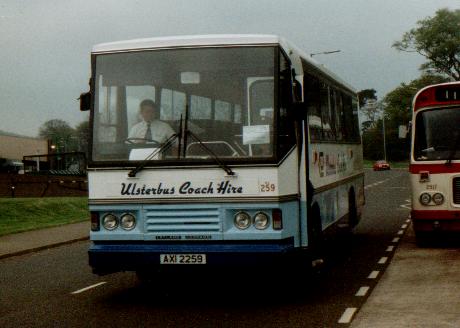
259 is half of the entire fleet of Wrights bodied Leopards in the Ulsterbus fleet, and was pictured
passing the Abbeycentre on April 29th 1995.(Photo copyright Shane Conway)
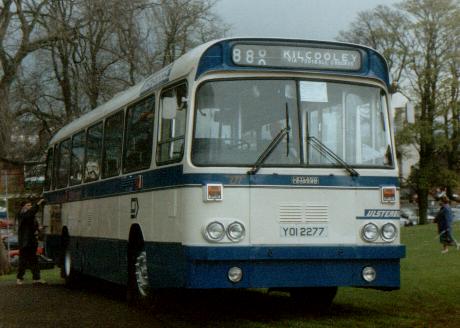
277 dates from 1982 and was photographed at Bangor Castle Park grounds on April 25th 1992.(Photo
copyright Shane Conway)
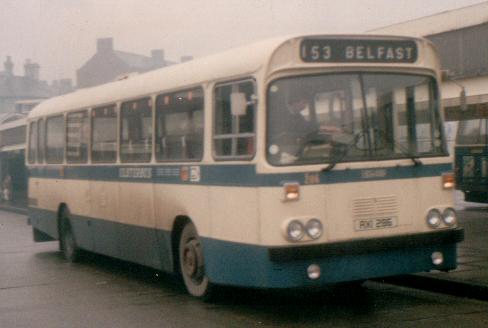
286 was one of 30 standard Leopards with AXI registrations, and the last batch of 20 had BXI marks
before deliveries of Leyland Tigers started. This wintry view was taken in Oxford Street on November 17th 1984.(Photo copyright
Shane Conway)
- 258 XOI 2258 Leyland PSU3E/4R 8030808 - Wrights DP53F B146 new 5/1982; w/d 1/2006; to Rankin, Glasgow 6/2006 for preservation **SURVIVOR**
- 259 AXI 2259 Leyland PSU3E/4R 8030829 - Wrights C53F B147 new 9/1982; driver trainer 3/1995 to 6/1995; w/d 1/2001; to Irish Transport Trust 1/2001 **SURVIVOR** Preserved
-
- 260 YOI 2260 Leyland PSU3E/4R 8030059 - Alexander (B) DP49F 750/1 new 6/1982; w/d 6/2006; to Cusick, Armoy 7/2006 for preservation **SURVIVOR**
- 261 YOI 2261 Leyland PSU3E/4R 8030082 - Alexander (B) DP49F 750/5 new 6/1982; w/d 5/2005 and sold for scrap 6/2005
- 262 YOI 2262 Leyland PSU3E/4R 8030089 - Alexander (B) DP49F 750/2 new 5/1982; w/d 5/2006 and sold for scrap 6/2006
- 263 YOI 2263 Leyland PSU3E/4R 8030108 - Alexander (B) DP49F 750/4 new 6/1982; destroyed in Coleraine 5/2000 and sold for scrap by 6/2000
- 264 YOI 2264 Leyland PSU3E/4R 8030109 - Alexander (B) DP49F 750/3 new 6/1982; destroyed in Milewater Road yard 4/1986 and sold for scrap 6/1986
- 265 YOI 2265 Leyland PSU3E/4R 8030110 - Alexander (B) DP49F 750/6 new 5/1982; w/d 4/2006 and sold for scrap 6/2006
- 266 YOI 2266 Leyland PSU3E/4R 8030111 - Alexander (B) DP49F 750/9 new 5/1982; destroyed in Milewater Road yard 4/1986 and sold for scrap 6/1986
- 267 YOI 2267 Leyland PSU3E/4R 8030112 - Alexander (B) DP49F 750/7 new 5/1982; w/d 5/2000 following accident damage and sold for scrap 2/2001
- 268 YOI 2268 Leyland PSU3E/4R 8030113 - Alexander (B) DP49F 750/8 new 5/1982; w/d 6/2006 and sold for scrap 9/2006
- 269 YOI 2269 Leyland PSU3E/4R 8030119 - Alexander (B) DP49F 750/10 new 5/1982; destroyed in Dungannon 8/1985 and sold for scrap 11/1985 (first of the batch to be withdrawn)
- 270 YOI 2270 Leyland PSU3E/4R 8030135 - Alexander (B) DP49F 750/12 new 9/1982; w/d 11/2003 and sold for scrap 8/2004
- 271 YOI 2271 Leyland PSU3E/4R 8030136 - Alexander (B) DP49F 750/11 new 6/1982; w/d 6/2006 and sold for scrap 10/2006
- 272 YOI 2272 Leyland PSU3E/4R 8030138 - Alexander (B) DP49F 750/14 new 6/1982; w/d 10/2005 and sold for scrap 5/2006
- 273 YOI 2273 Leyland PSU3E/4R 8030144 - Alexander (B) DP49F 750/13 new 5/1982; w/d 6/2006 and sold for scrap 10/2006
- 274 YOI 2274 Leyland PSU3E/4R 8030145 - Alexander (B) DP49F 750/15 new 5/1982; w/d 2/2006; to Thompson, Newtownards 11/2006 for preservation **SURVIVOR**
- 275 YOI 2275 Leyland PSU3E/4R 8030148 - Alexander (B) DP49F 750/16 new 6/1982; w/d 6/2006; to Lawson, Kirkcubbin 7/2006 for preservation **SURVIVOR**
- 276 YOI 2276 Leyland PSU3E/4R 8030149 - Alexander (B) DP49F 750/19 new 6/1982; w/d 11/2005 and sold for scrap 5/2006
- 277 YOI 2277 Leyland PSU3E/4R 8030153 - Alexander (B) DP49F 750/18 new 6/1982; w/d 8/2004 and sold for scrap 9/2005 (although noted in breakers yard 6/2005)
- 278 YOI 2278 Leyland PSU3E/4R 8030162 - Alexander (B) DP49F 750/20 new 6/1982; w/d 3/2006 and sold for scrap 9/2006
- 279 YOI 2279 Leyland PSU3E/4R 8030169 - Alexander (B) DP49F 750/17 new 6/1982; w/d 6/2006 and sold for scrap 10/2006
-
- 280 AXI 280 Leyland PSU3E/4R 8030336 - Alexander (B) B53F 752/2 new 6/1982; w/d 10/2005; r/r FEZ 7746 12/2005; to Thompson, Newtownards 1/2006 for preservation; r/r AIG 280 by 9/2006 **SURVIVOR**
- 281 AXI 281 Leyland PSU3E/4R 8030337 - Alexander (B) B53F 752/6 new 9/1982; w/d 10/2005; r/r GEZ 1425 1/2006; sold for scrap 9/2006
- 282 AXI 282 Leyland PSU3E/4R 8030369 - Alexander (B) B53F 752/4 new 7/1982; w/d 11/2005; r/r IEZ 2529 5/2006; sold for scrap 10/2006
- 283 AXI 283 Leyland PSU3E/4R 8030370 - Alexander (B) B53F 752/3 new 6/1982; r/r IEZ 2530 5/2006; w/d 6/2006 and sold for scrap 8/2006
- 284 AXI 284 Leyland PSU3E/4R 8030373 - Alexander (B) B53F 752/9 new 7/1982; destroyed in Portrush 5/2004 and sold for scrap 5/2004
- 285 AXI 285 Leyland PSU3E/4R 8030379 - Alexander (B) B53F 752/10 new 6/1982; w/d 4/2006; to Dixon, Warringstown 6/2007 for preservation; to Davis, Kirk Michael 8/2013 for preservation **SURVIVOR**
- 286 AXI 286 Leyland PSU3E/4R 8030380 - Alexander (B) B53F 752/11 new 7/1982; r/r GEZ 8109 2/2006; w/d 2/2006; to Miller, Ballyclare 11/2006 for preservation; to Nogues, Bangor 2/2011 for preservation; r/r AIG 286 9/2011; to Graham, Kesh 1/2012 for preservation **SURVIVOR**
- 287 AXI 287 Leyland PSU3E/4R 8030382 - Alexander (B) B53F 752/7 new 7/1982; r/r EEZ 6840 8/2005; w/d 1/2006 and sold for scrap 5/2006
- 288 AXI 288 Leyland PSU3E/4R 8030383 - Alexander (B) B53F 752/1 new 7/1982; still with Ulsterbus **SURVIVOR**
- 289 AXI 289 Leyland PSU3E/4R 8030384 - Alexander (B) B53F 752/5 new 7/1982; r/r FEZ 5365 10/2005; w/d 10/2005 and sold for scrap 5/2006
- 290 AXI 290 Leyland PSU3E/4R 8030385 - Alexander (B) B53F 752/8 new 10/1982; w/d 6/2006; r/r JEZ 7369 9/2006; sold for scrap 10/2006; chassis to Harkin and Lockhart, Derry for spares 2/2007
- 291 AXI 291 Leyland PSU3E/4R 8030392 - Alexander (B) B53F 752/17 new 7/1982; w/d 1/2006 and sold for scrap 10/2006
- 292 AXI 292 Leyland PSU3E/4R 8030446 - Alexander (B) B53F 752/15 new 6/1982; destroyed in Armagh 4/1985 and sold for scrap by 9/1993 (first of the batch to be withdrawn)
- 293 AXI 293 Leyland PSU3E/4R 8030447 - Alexander (B) B53F 752/12 new 6/1982; destroyed in Coalisland 8/1989 and sold for scrap ?/??
- 294 AXI 294 Leyland PSU3E/4R 8030469 - Alexander (B) B53F 752/13 new 7/1982; w/d 12/2005; r/r IEZ 3179 5/2006; to Harkin and Lockhart, Derry 2/2007 for preservation **SURVIVOR**
- 295 AXI 295 Leyland PSU3E/4R 8030472 - Alexander (B) B53F 752/20 new 11/1982; w/d 10/2005; r/r IEZ 3180 5/2006; sold for scrap 5/2006
- 296 AXI 296 Leyland PSU3E/4R 8030517 - Alexander (B) B53F 752/19 new 7/1982; w/d 11/2005; r/r JEZ 2953 7/2006; sold for scrap 10/2006
- 297 AXI 297 Leyland PSU3E/4R 8030528 - Alexander (B) B53F 752/18 new 10/1982; w/d 10/2005; r/r JEZ 3347 7/2006; sold for scrap 10/2006
- 298 AXI 298 Leyland PSU3E/4R 8030584 - Alexander (B) B53F 752/16 new 9/1982; w/d 10/2005; r/r JEZ 3348 7/2006; sold for scrap 10/2006
- 299 AXI 299 Leyland PSU3E/4R 8030585 - Alexander (B) B53F 752/14 new 6/1982; w/d 6/2006; r/r JEZ 2954 7/2006; to Harkin, Derry 11/2006 for preservation **SURVIVOR**
-
- 310 AXI 310 Leyland PSU3F/4R 8131064 - Alexander (B) B53F 752/27 new 10/1982; destroyed in Belfast 8/1983 and sold for scrap 8/1983 (first of the batch to be withdrawn)
- 311 AXI 311 Leyland PSU3F/4R 8131160 - Alexander (B) B53F 752/21 new 9/1982; w/d 12/2005; r/r GEZ 8111 2/2006; sold for scrap 5/2006
- 312 AXI 312 Leyland PSU3F/4R 8131163 - Alexander (B) B53F 752/22 new 9/1982; w/d 10/2005; r/r GEZ 8112 2/2006; sold for scrap 5/2006
- 313 AXI 313 Leyland PSU3F/4R 8131165 - Alexander (B) B53F 752/24 new 9/1982; w/d 12/2005; r/r GEZ 8113 2/2006; sold for scrap 10/2006
- 314 AXI 314 Leyland PSU3F/4R 8131173 - Alexander (B) B53F 752/29 new 10/1982; w/d 10/2005; r/r GEZ 8114 2/2006; sold for scrap 5/2006
- 315 AXI 315 Leyland PSU3F/4R 8131186 - Alexander (B) B53F 752/25 new 9/1982; w/d 10/2005; r/r GEZ 8115 2/2006; sold for scrap 5/2006
- 316 AXI 316 Leyland PSU3F/4R 8131205 - Alexander (B) B53F 752/23 new 9/1982; w/d 6/2006; r/r JEZ 6821 9/2006; sold for scrap 10/2006
- 317 AXI 317 Leyland PSU3F/4R 8131212 - Alexander (B) B53F 752/26 new 10/1982; w/d 10/2005; r/r GEZ 8116 2/2006; sold for scrap 5/2006
- 318 AXI 318 Leyland PSU3F/4R 8131226 - Alexander (B) B53F 752/30 new 11/1982; w/d 10/2005; r/r GEZ 8117 2/2006; sold for scrap 5/2006
- 319 AXI 319 Leyland PSU3F/4R 8131241 - Alexander (B) B53F 752/28 new 10/1982; w/d 10/2005; r/r GEZ 8118 2/2006; to Kells Transport Museum 4/2007; scrapped -/2020
- 320 BXI 320 Leyland PSU3F/4R 8131256 - Alexander (B) DP49F 750/21 new 11/1982; w/d 10/2005; r/r FEZ 5461 11/2005; to Harkin, Derry 6/2006 for preservation **SURVIVOR**
- 321 BXI 321 Leyland PSU3F/4R 8131257 - Alexander (B) DP49F 750/22 new 11/1982; w/d 11/2005; r/r GEZ 8119 2/2006; sold for scrap 5/2006
- 322 BXI 322 Leyland PSU3F/4R 8131258 - Alexander (B) DP49F 750/23 new 12/1982; w/d 10/2005; r/r GEZ 8121 2/2006; sold for scrap 5/2006
- 323 BXI 323 Leyland PSU3F/4R 8131265 - Alexander (B) DP49F 750/25 new 12/1982; w/d 10/2005; r/r GEZ 8122 2/2006; sold for scrap 5/2006
- 324 BXI 324 Leyland PSU3F/4R 8131266 - Alexander (B) DP49F 750/24 new 12/1982; driver trainer 5/2005 to 11/2005; w/d 11/2005; r/r LEZ 1826 12/2006; sold for scrap 12/2006
- 328 BXI 328 Leyland PSU3F/4R 8131331 - Alexander (B) DP49F 750/27 new 12/1982; r/r FEZ 8628 11/2005; w/d 11/2005; to Hamill, Ahoghill (dealer) 5/2007; to Graham, Kesh 4/2010 for preservation **SURVIVOR**
-
- 955 MDS 668P Leyland AN68A/201R 7505769 - Alexander H45/31F AL39/1374/55 new 1/1976 (as Greater Glasgow PTE LA1005); ex Strathclyde PTE LA1005 3/1982; w/d 3/1987 and sold for scrap 3/1989
- 956 MDS 669P Leyland AN68A/201R 7505770 - Alexander H45/31F AL39/1374/56 new 1/1976 (as Greater Glasgow PTE LA1006); ex Strathclyde PTE LA1006 3/1982; w/d 6/1992; to McDonald's Restaurant, Bangor 11/1993; burnt out 10/1999 and sold for scrap ?/??
- 957 KSU 865P Leyland AN68A/201R 7504793 - Alexander H45/31F AL39/1374/39 new 11/1975 (as Greater Glasgow PTE LA989); ex Strathclyde PTE LA989 3/1982; w/d 6/1992; to North East Institute of Further and Higher Education 2/1995; w/d by 5/1998 and sold for scrap 5/1998
- 958 KSU 867P Leyland AN68A/201R 7504895 - Alexander H45/31F AL39/1374/41 new 12/1975 (as Greater Glasgow PTE LA991); ex Strathclyde PTE LA991 3/1982; w/d 12/1986 and sold for scrap by 9/1993
- 959 KSU 869P Leyland AN68A/201R 7505321 - Alexander H45/31F AL39/1374/43 new 12/1975 (as Greater Glasgow PTE LA993); ex Strathclyde PTE LA993 3/1982; w/d 11/1988 and sold for scrap 10/1989
- 960 KSU 872P Leyland AN68A/201R 7505568 - Alexander H45/31F AL39/1374/46 new 2/1976 (as Greater Glasgow PTE LA996); ex Strathclyde PTE LA996 3/1982; w/d 5/1991 and sold for scrap 6/1996
- 961 KSU 873P Leyland AN68A/201R 7505565 - Alexander H45/31F AL39/1374/47 new 12/1975 (as Greater Glasgow PTE LA997); ex Strathclyde PTE LA997 3/1982; w/d 1/1990 and sold for scrap 10/1990
- 962 KSU 875P Leyland AN68A/201R 7505055 - Alexander H45/31F AL39/1374/49 new 12/1975 (as Greater Glasgow PTE LA999); ex Strathclyde PTE LA999 3/1982; w/d 8/1988 and sold for scrap 2/1990
- 963 JUS 776N Leyland AN68/201R 7501562 - Alexander H45/31F AL38/1174/29 new 6/1975 (as Greater Glasgow PTE LA929); ex Strathclyde PTE LA929 8/1982; used as driver trainer 4/1990 to 9/1990; w/d 9/1990 and sold for scrap 9/1990
- 964 HGG 247N Leyland AN68/201R 7500226 - Alexander H45/31F AL33/4570/249 new 3/1975 (as Greater Glasgow PTE LA898); ex Strathclyde PTE LA898 8/1982; w/d 10/1987 and sold for scrap by 9/1993
- 965 GGG 303N Leyland AN68/201R 7404156 - Alexander H45/31F AL33/4570/202 new 11/1974 (as Greater Glasgow PTE LA851); ex Strathclyde PTE LA851 8/1982; w/d 6/1990 and sold for scrap by 6/1991
- 966 GGG 305N Leyland AN68/201R 7404243 - Alexander H45/31F AL33/4570/204 new 11/1974 (as Greater Glasgow PTE LA853); ex Strathclyde PTE LA853 8/1982; w/d 3/1989 and sold for scrap by 6/1991
- 967 GGG 307N Leyland AN68/201R 7404242 - Alexander H45/31F AL33/4570/206 new 11/1974 (as Greater Glasgow PTE LA855); ex Strathclyde PTE LA855 8/1982; w/d 9/1982 and sold for scrap by 9/1993
- 968 GGG 308N Leyland AN68/201R 7404157 - Alexander H45/31F AL33/4570/207 new 11/1974 (as Greater Glasgow PTE LA856); ex Strathclyde PTE LA856 8/1982; w/d 10/1986 and sold for scrap by 9/1993
- 969 KSU 849P Leyland AN68A/201R 7504073 - Alexander H45/31F AL39/1374/23 new 10/1975 (as Greater Glasgow PTE LA973); ex Strathclyde PTE LA973 8/1982; w/d 11/1988 and sold for scrap 2/1990
- 970 KSU 852P Leyland AN68A/201R 7503957 - Alexander H45/31F AL39/1374/26 new 10/1975 (as Greater Glasgow PTE LA976); ex Strathclyde PTE LA976 8/1982; destroyed in Omagh 3/1983 and sold for scrap 4/1983
-
- 2455 WOI 2455 Bristol RELL6G RELL-3-2612 - Alexander (B) B52F 563/31 new 1/1982; w/d 11/2003; to Lough Swilly 448 12/2003; r/r 82 DL 1421 12/2003; w/d 2/2006 and sold for scrap by 6/2006
- 2459 WOI 2459 Bristol RELL6G RELL-3-2616 - Alexander (B) B52F 563/35 new 5/1982; w/d 6/1999 and sold for scrap 3/2002
- 2460 WOI 2460 Bristol RELL6G RELL-3-2617 - Alexander (B) B52F 563/34 new 6/1982; w/d 6/2003; to Wealden PSV Sales, Tonbridge 7/2004 **SURVIVOR**
- 2581 BXI 2581 Bristol RELL6G RELL-3-2738 - Alexander (B) B52F 754/5 new 11/1982; w/d 10/1990; to Citybus 2581 10/1990; w/d 9/2000; to Ulsterbus 2581 9/2000; w/d 11/2003; to Lough Swilly 450 12/2003; r/r 82 DL 1423 12/2003; w/d 6/2006; used as storeshed at Springtown; sold for scrap 10/2009
- 2582 BXI 2582 Bristol RELL6G RELL-3-2739 - Alexander (B) B52F 754/3 new 11/1982; destroyed in Milewater Road yard 4/1986 and sold for scrap 6/1986 (first of batch to be withdrawn)
- 2583 BXI 2583 Bristol RELL6G RELL-3-2740 - Alexander (B) B52F 754/4 new 11/1982; w/d 10/1990; to Citybus 2583 11/1990; w/d 9/2000; to Ulsterbus 2583 9/2000; w/d 11/2003; to Irish Transport Trust 3/2005 **SURVIVOR**
- 2584 BXI 2584 Bristol RELL6G RELL-3-2741 - Alexander (B) B52F 754/2 new 11/1982; w/d 9/2003; to Sullivan, Potters Bar by 8/2004 **SURVIVOR**
- 2585 BXI 2585 Bristol RELL6G RELL-3-2742 - Alexander (B) B52F 754/1 new 11/1982; destroyed in Monkstown 5/1986 and sold for scrap 12/1986
- 2586 BXI 2586 Bristol RELL6G RELL-3-2743 - Alexander (B) B52F 754/6 new 12/1982; destroyed in Newtownabbey 11/1986 and sold for scrap 7/1987
- 2589 BXI 2589 Bristol RELL6G RELL-3-2746 - Alexander (B) B52F 754/7 new 12/1982; w/d 1/2004; to Haughey, Forkhill 3/2004 **SURVIVOR** Preserved
-
- 3000 WOI 607 Leyland Lion B21-007 - Alexander (B) B44D 680/1 new 2/1982; w/d by 10/1991; to Ipswich Borough Transport 148 10/1991; r/r YBJ 159X
And finally, here's a summary of what vehicles received the original numbers from all the Leopards which
were re-registered by Ulsterbus. The apparent overlap where the same registration number was on two different vehicles at the
same time was due to delays with the Northern Ireland Vehicle Licensing Authority.
- ROI 107
- ROI 108
- ROI 109
- ROI 111
- ROI 117
- ROI 118: Advertised for sale 3/2006
- ROI 119
- ROI 120: Advertised for sale 3/2006
- ROI 122: to private car 3/2008 (ex Share Centre)
- ROI 126: to Ulsterbus Optare Solo 1926 11/2005; to Ulsterbus Scania 126 5/2009
- ROI 127
- ROI 128: Advertised for sale 3/2006
- ROI 129: to Ulsterbus Optare Solo 1929 11/2005; to Ulsterbus Scania 129 5/2009
- ROI 130
- ROI 131: Ford Mondeo car
- ROI 132: to Ulsterbus Optare Solo 1932 1/2006
- ROI 133
- ROI 134: to Ulsterbus Optare Solo 1924 10/2005; to Ulsterbus Scania 124 5/2009
- ROI 135: Advertised for sale 3/2006
- ROI 139: to Ulsterbus Optare Solo 1919 8/2005
- ROI 140: Advertised for sale 3/2006
- ROI 141: to Citybus Optare Solo 1921 9/2005
- ROI 145: to Ulsterbus Optare Solo 1925 10/2005; to Ulsterbus Scania 125 5/2009
- ROI 146: Advertised for sale 3/2006
- ROI 147
- ROI 148: Advertised for sale 3/2006
- ROI 150
- VOI 171
- VOI 172
- VOI 177
- VOI 178: to Coastalbus, Kilrea
- VOI 179
- VOI 182
- VOI 186
- VOI 187
- VOI 188: to Ulsterbus Optare Solo 1918 8/2005
- VOI 189
- VOI 190
- VOI 192
- VOI 194
- VOI 195
- VOI 198
- VOI 199
- VOI 200: to Citybus Optare Solo 1920 8/2005
- VOI 203: to Citybus Optare Solo 1923 8/2005
- VOI 204
- VOI 205: to Citybus Optare Solo 1922 8/2005
- VOI 206
- WOI 2217: Seat Ibiza car by 3/2007
- WOI 2222
- AXI 280: to Vauxhall car
- AXI 281
- AXI 282: to Ulsterbus Ayats Bravo 2002 8/2006
- AXI 283: to Ulsterbus Ayats Bravo 2003 7/2006
- AXI 286
- AXI 287: to Ulsterbus Optare Solo 1917 8/2005
- AXI 289
- AXI 290: to Ulsterbus Ayats Bravo 2010 6/2006
- AXI 294: to Ulsterbus Ayats Bravo 2004 6/2006
- AXI 295: to Ulsterbus Ayats Bravo 2005 6/2006
- AXI 296: to Ulsterbus Ayats Bravo 2006 6/2006
- AXI 297: to Ulsterbus Ayats Bravo 2007 6/2006
- AXI 298: to Ulsterbus Ayats Bravo 2008 7/2006
- AXI 299: to Ulsterbus Ayats Bravo 2009 7/2006
- AXI 311: to Ulsterbus Leyland Tiger 1311 2/2006 to 9/2006; to Ulsterbus Ayats Bravo 2011 6/2006
- AXI 312: to Ulsterbus Leyland Tiger 1312 2/2006 to 9/2006; to Ulsterbus Ayats Bravo 2012 7/2006
- AXI 313: to Ulsterbus Leyland Tiger 1313 2/2006 to 9/2006; to Ulsterbus Ayats Bravo 2013 7/2006
- AXI 314: to Ulsterbus Mercedes 811D 1814 2/2006 to 9/2006; to Ulsterbus Ayats Bravo 2014 8/2006
- AXI 315: to Ulsterbus Leyland Tiger 1315 2/2006 to 9/2006; to Ulsterbus Ayats Bravo 2015 9/2006
- AXI 316: to Ulsterbus Ayats Bravo 2016 9/2006
- AXI 317: to Ulsterbus Leyland Tiger 1317 2/2006 to 10/2006; to Ulsterbus Ayats Bravo 2017 10/2006
- AXI 318: to Ulsterbus Leyland Tiger 1318 2/2006 to 10/2006; to Ulsterbus Ayats Bravo 2018 1/2007
- AXI 319: to Ulsterbus Leyland Tiger 1319 2/2006 to 10/2006; to Ulsterbus Ayats Bravo 2019 12/2006
- BXI 320: to Ulsterbus Ayats Bravo 2020 12/2006
- BXI 321: to Ulsterbus Leyland Tiger 1321 2/2006 to 10/2006; to Ulsterbus Ayats Bravo 2021 10/2006
- BXI 322: to Ulsterbus Leyland Tiger 1322 2/2006 to 10/2006; to Ulsterbus Ayats Bravo 2022 10/2006
- BXI 323: to Ulsterbus Leyland Tiger 1323 2/2006 to 3/2007; to Ulsterbus Ayats Bravo 2023 6/2007
- BXI 324: to Ulsterbus Ayats Bravo 2024 10/2006
- BXI 325: to Ulsterbus Leopard 330 5/2006 to 10/2006; to Ulsterbus Ayats Bravo 2025 10/2006
- BXI 326: to Ulsterbus Ayats Bravo 2026 1/2007
- BXI 328: to Ulsterbus Optare Solo 1928 11/2005; to Ulsterbus Scania 128 5/2009
- BXI 330: to Ulsterbus Optare Solo 1930 1/2006
- BXI 331: to Ulsterbus Optare Solo 1931 4/2007
- BXI 333: to Ulsterbus Optare Solo 1933 4/2006
- BXI 336
- BXI 337: to Ulsterbus Optare Solo 1927 10/2005; to Ulsterbus Scania 127 5/2009
Email
Classic U.K. Buses
Classic Irish Buses
Classic Manx Buses
SB



















